Fiplex Communications H7 BI-DIRECTIONAL AMPLIFIER User Manual TETRA User s Manual
Fiplex Communications Inc BI-DIRECTIONAL AMPLIFIER TETRA User s Manual
user manual
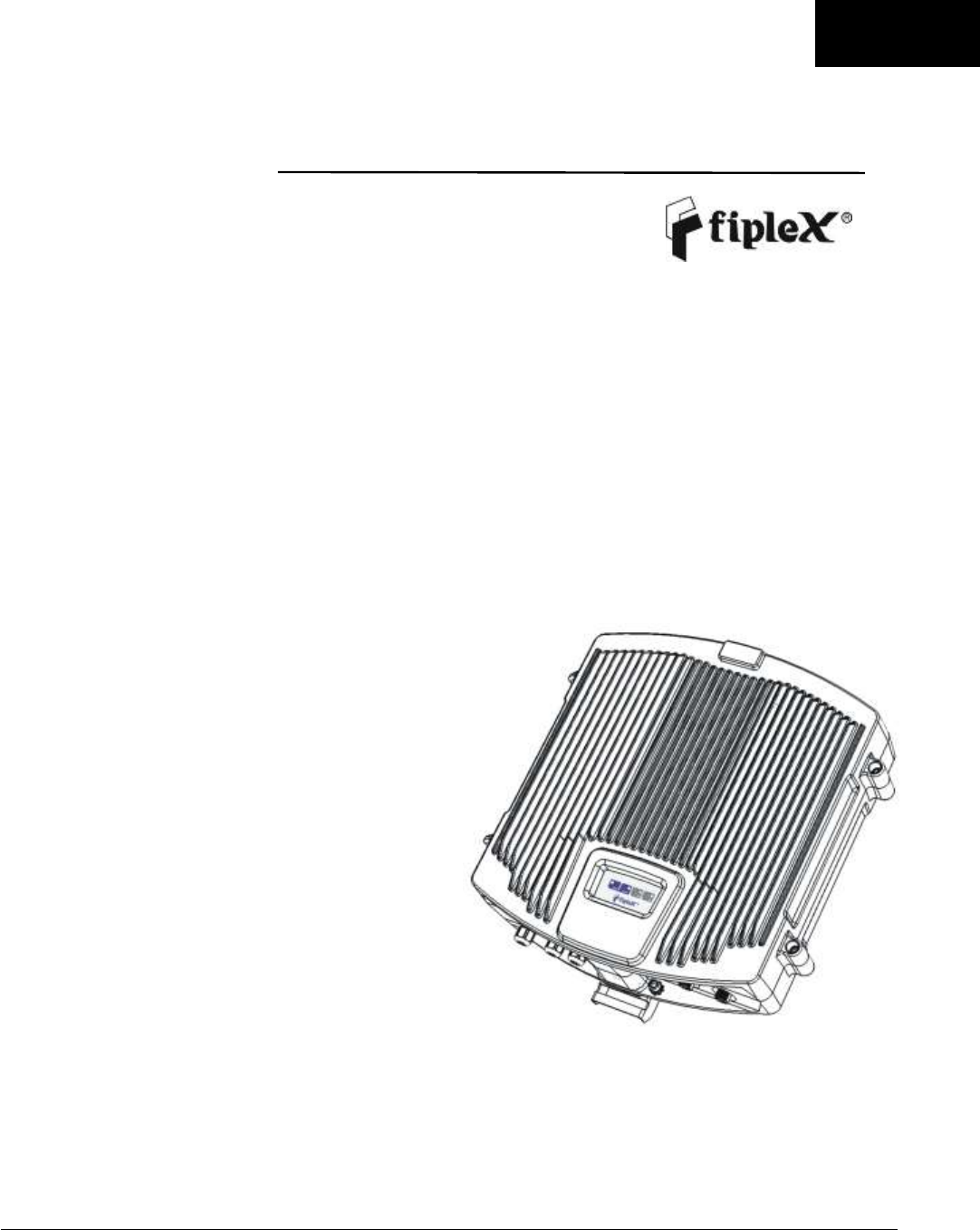
UM-0825 1
English
H7 Series - Compact Signal Booster
User & Installation Manual
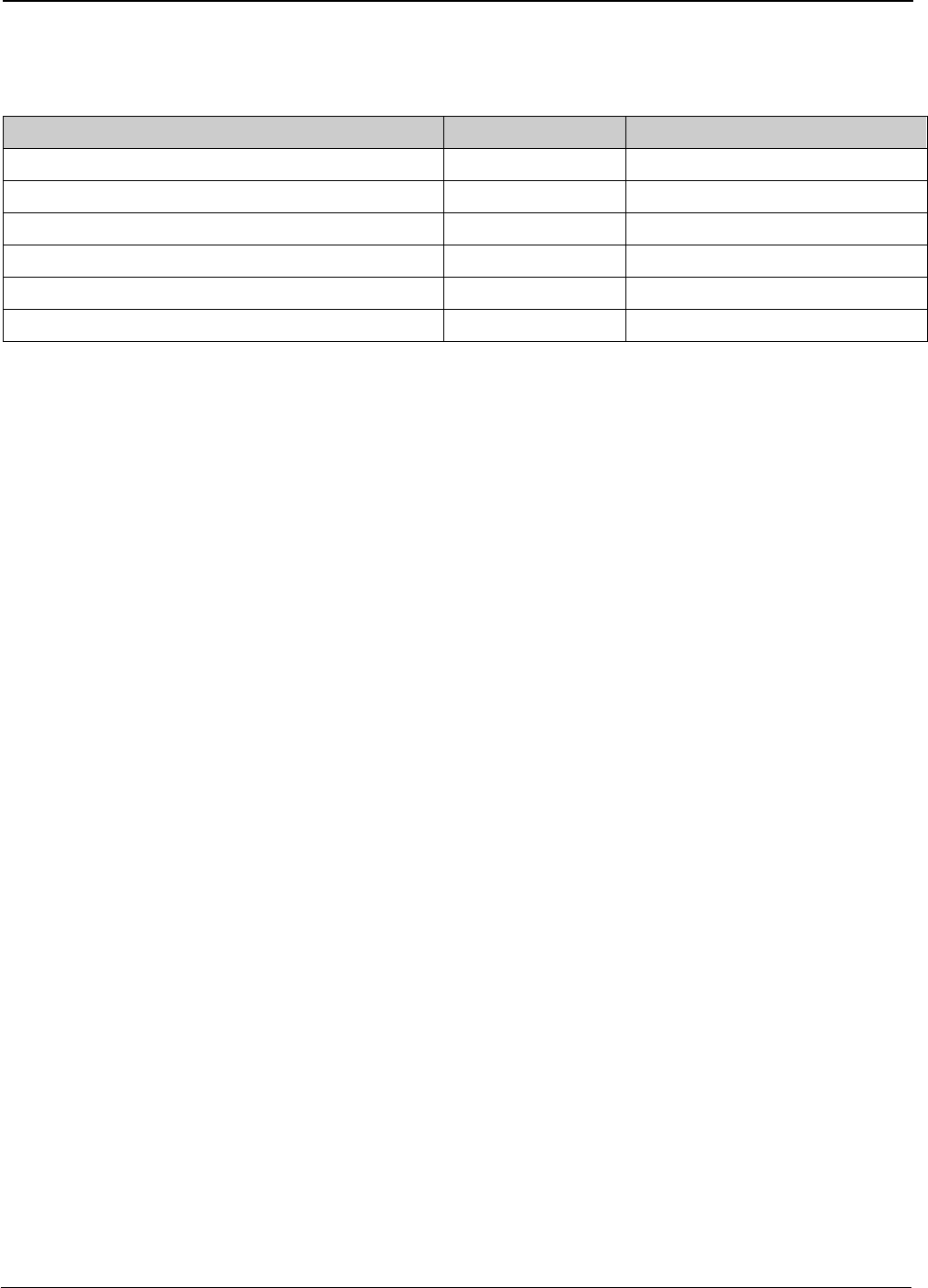
UM-0825 2
Document History
Description
Revision
Date Issued
Preliminary release for early field trials
1.0
August 3rd, 2009
Indicator panel, and cabinet modifications
2.0
April 13th, 2010
Software screenshots updated
3.0
August 20th, 2010
Update for generic version and pFOMs v3.0
4.0
June 5th , 2012
pFOMS installer updated
5.0
August 12th, 2012
General review
6.0
July 2nd, 2014

UM-0825 3
About this manual
This manual describes installation, commissioning, operation and maintenance of Fiplex H7 Series Compact Signal Booster,
and Fiplex portable Operational and Maintenance Software (pFOMS). The first part of the manual describes the Signal
Booster hardware and the second part describes the software.
Hardware and software mentioned in this manual are subjected to continuous development and improvement. Consequently,
there may be minor discrepancies between the information in the manual and the performance and design of the hardware
and software. Specifications, dimensions and other statements mentioned in this manual are subject to change without notice.
This manual or parts of it may not be reproduced without the written permission of Fiplex Communications Inc.
Infringements will be prosecuted. All rights reserved.
Copyright © Fiplex Communications Inc, Miami, 2015.

UM-0825 4
Contents
Part 1 HARDWARE ......................................................................................................................... 6
1. Safety ............................................................................................................................................................ 6
2. Product Description. ..................................................................................................................................... 9
Dimensions .................................................................................................................................................... 10
3. Signal Booster Block Diagram .................................................................................................................... 11
4. Installation ................................................................................................................................................... 11
Mounting ........................................................................................................................................................ 12
Starting operation........................................................................................................................................... 18
Auto-oscillation Condition .............................................................................................................................. 19
Status Indicators ............................................................................................................................................ 19
Automatic Gain Control (AGC) ...................................................................................................................... 20
Overload Protection ....................................................................................................................................... 21
Laboratory Measurements ............................................................................................................................. 21
Part 2 SOFTWARE ....................................................................................................................... 22
5. Installation ................................................................................................................................................... 22
6. Software Installation Troubleshooting Guide .............................................................................................. 25
6.1. Driver installation failure ..................................................................................................................... 25
6.2. Device Unknown legend in driver. ...................................................................................................... 28
6.3. Failed to connect to device ................................................................................................................. 30
7. Using Portable OMS Software .................................................................................................................... 31
8. Overview ..................................................................................................................................................... 34
General Tabsheet .......................................................................................................................................... 34
Status tab sheet ............................................................................................................................................. 35
Configuration .................................................................................................................................................. 36
Update Features ............................................................................................................................................ 37
ANNEX 1 - 24 Volts DC Operation ................................................................................................ 38
ANNEX 2 – Replacing +5VDC DC-DC Converter .......................................................................... 40

UM-0825 5
Abbreviations
AGC Automatic Gain Control
AMPS Advanced Mobile Phone Service
ARFCN Absolute Radio Frequency Channel Number
BCCH Broadcast Control Channel (GSM broadcast channel time slot)
BS Base Station, BS antenna = towards the base station
CDMA Code Division Multiple Access
DC Direct Current
DCS Digital Communication System (same as PCN)
DL Downlink signal direction (from base station via Signal Booster to mobile station)
DPLX Duplex filter
EEPROM Electrical Erasable Programmable Read Only Memory
EGSM Extended Global System for Mobile communication
ETACS Extended Total Access Communication System
ETSI European Telecommunications Standard Institute
GSM Global System for Mobile communication
HW Hardware
LED Light Emitting Diode
LNA Low Noise Amplifier, uplink and downlink
MS Mobile Station, MS antenna = towards the mobile station
OMS Operation and Maintenance System
OL Overload
PA Power Amplifier
PCN Personal Communication Network (same as DCS)
PCS Personal Communication System
pFOMS Portable Fiplex Operation and Maintenance Software
PS Power Supply
RF Radio Frequency
RSSI Received Signal Strength Indication
SW Software
TDMA Time Division Multiple Access
UL Uplink signal direction (from mobile station via Signal Booster to base station)
WEEE Waste of Electric and Electronic Equipment
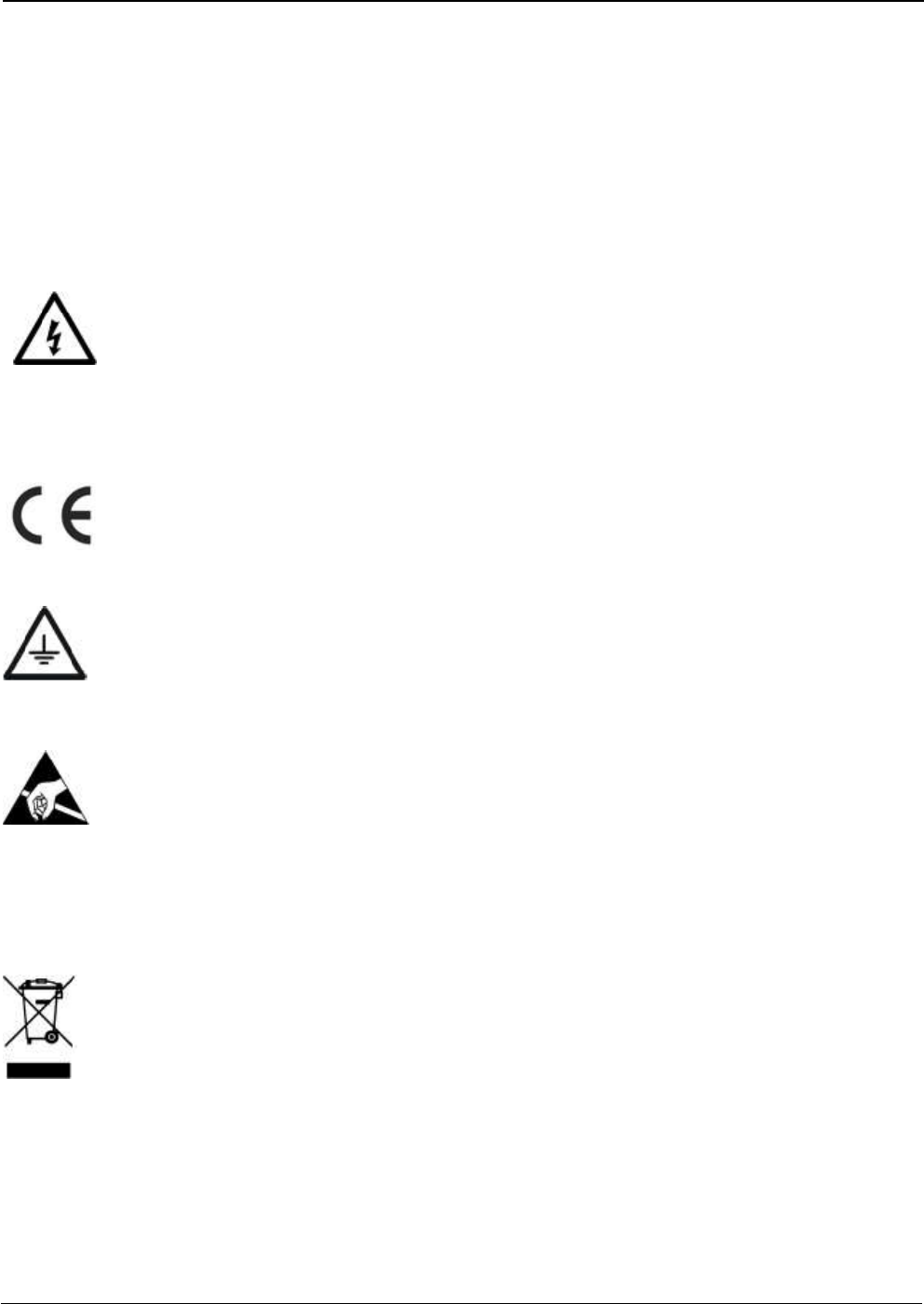
UM-0825 6
Part 1 HARDWARE
1. Safety
Caution!
This manual lists a set of rules and warnings to be accomplished when installing, commissioning and operating
a Fiber DAS Master Optical Unit from FIPLEX. Any omission may result in damage and/or injuries to the System
and/or the System Operators or Users.
If an instruction is not clear or you consider is missing, please contact immediately to Fiplex. See
www.fiplex.com for contact information.
Dangerous Voltage Warning
Any personnel involved in installation, operation or service of this equipment must understand and obey the
following: The power supply unit supplied from the main power contains dangerous voltage
level, which can cause electric shock. Switch the main power off prior to any work
in such equipment. Any local regulations are to be followed when servicing MOUs.
Authorized service personnel only are allowed to service repeaters while the main
is switched on.
R&TTE Compliance Statement
This equipment complies with the appropriate essential requirements of Article 3 of the R&TTE Directive
1999/5/EC.
Station Ground
BTS chassis, Signal Booster, feeders, donor antenna, service antenna/s and auxiliary equipment (splitters,
tabs, .etc) are required to be bonded to protective grounding using the bonding stud or screw provided with
each unit.
Electrostatic Discharge
Static electricity means no risk of personal injury but it can severely damage essential parts of the Signal
Booster, if not handled carefully.
Parts on the printed circuit boards as well as other parts in the Signal Booster are sensitive to electrostatic
discharge.
Never touch printed circuit boards or uninsulated conductor surfaces unless absolutely necessary.
If you must handle printed circuit boards or uninsulated conductor surfaces, use ESD protective equipment, or
first touch the Signal Booster chassis with your hand and then do not move your feet on the floor.
Never let your clothes touch printed circuit boards or uninsulated conductor surfaces.
Disposal of Electric and Electronic Waste
Pursuant to the WEEE EU Directive electronic and electrical waste must not be disposed of with unsorted
waste. Please contact your local recycling authority for disposal of this product.
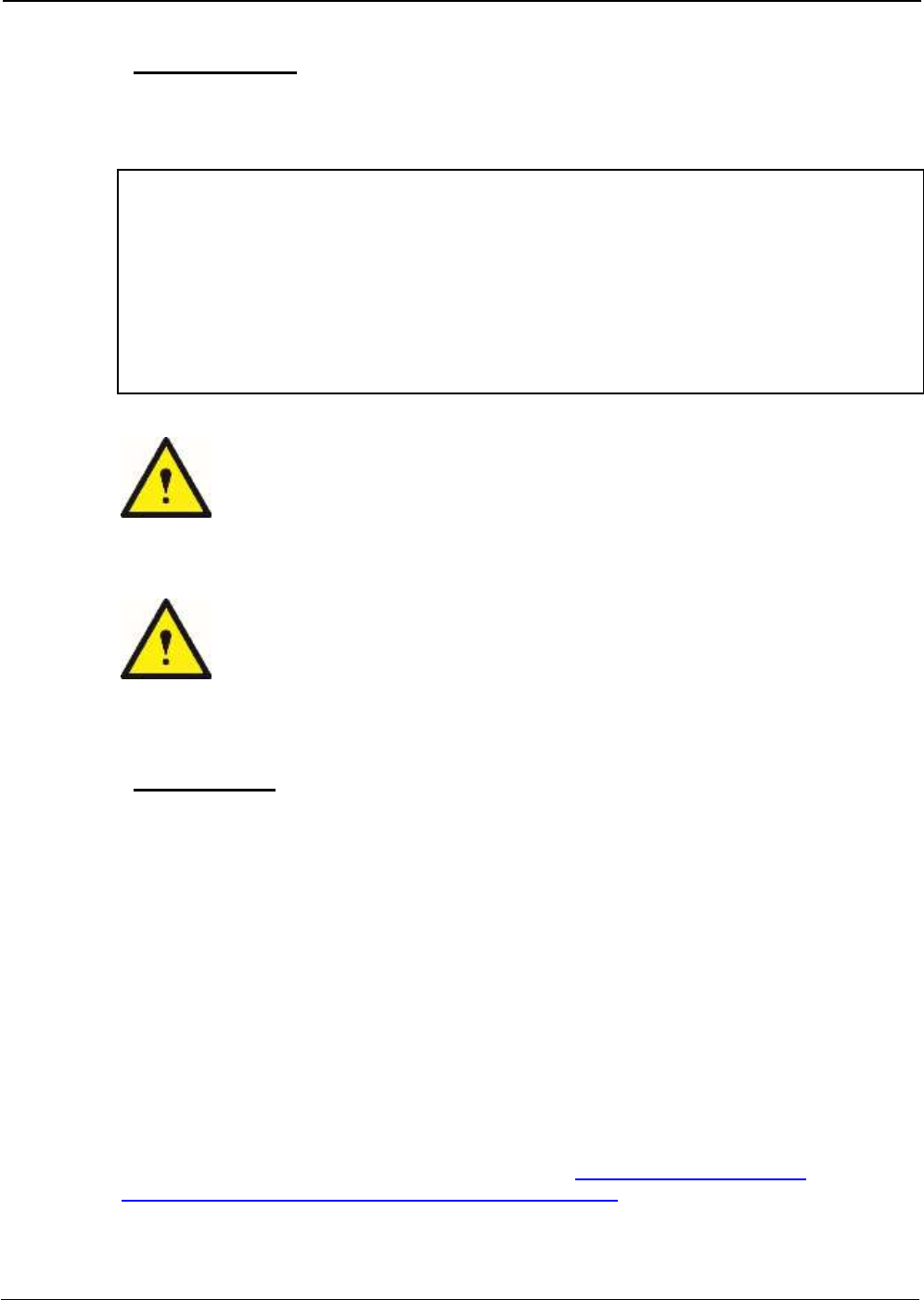
UM-0825 7
FCC Compliance
This is a 90.219 Class B device.
WARNING: This is a 90.219 Class B device. This is NOT a CONSUMER device. It is designed
for installation by FCC LICENSEES and QUALIFIED INSTALLERS. You MUST have an FCC
LICENSE or express consent of an FCC Licensee to operate this device. You MUST register
Class B signal boosters (as defined in 47 CFR 90.219) online at www.fcc.gov/signal-
boosters/registration. Unauthorized use may result in significant forfeiture penalties, including
penalties in excess of $100,000 for each continuing violation. The installation procedure must
result in the signal booster complying with FCC requirements 90.219(d). In order to meet FCC
requirements 90.219(d), it may be necessary for the installer to reduce the UL and/or DL output
power for certain installations.
ATTENTION: This device complies with Part 15 of the FCC rules. Operation is subject
to the following two conditions: (1) this device may not cause harmful interference and
(2) this device must accept any interference received, including interference that may
cause undesired operation.
ATTENTION: FCC regulation mandate that the ERP of type B signal boosters should
not exceed 5W. This Signal Booster has a composite output power of 1W, therefore
the gain of the DL antenna should be of 6dBi or less and maintain a minimum
separation of 25 cm from all persons, and the gain of the UL antenna should be 13dBi
or less and maintain a minimum separation of 28cm from all persons.
IC Compliance
As per RSS 131 Issue 2:
Nominal passband gain: 80dB max
Nominal bandwidth: 8MHz maximum for Canada market
Rated mean output power: Up to +30dBm
Input and Output imedances: 50 ohms
The Manufacturer's rated output power of this equipment is for single carrier operation. For
situations when multiple carrier signals are present, the rating would have to be reduced by 3.5
dB, especially where the output signal is re-radiated and can cause interference to adjacent band
users. This power reduction is to be by means of input power or gain reduction and not by an
attenuator at the output of the device.
RF Exposure Statement for ISED: “This device complies with Health Canada’s Safety Code. The
installer of this device shouldensure that RF radiation is not emitted in excess of the Health
Canada’s requirement. Information can be obtained at http://www.hc-sc.gc.ca/ewh-
semt/pubs/radiation/radio_guide-lignes_direct/index-eng.php”

UM-0825 8
The antenna/s used for this transmitter must be installed to provide a separation of at least 40 cm
in DL and 45 cm in UL from all persons and must not be collocated or operating in conjunction
with any other antenna or transmitter. Changes or modifications not expressly approved by the
party responsible for compliance could void the user’s authority to operate the equipment.
Selon RSS 131 Issue 2:
• Gain de bande passante nominal: 80dB max
• Bande passante nominale: 8MHz maximum pour le marché canadien
• Puissance nominale de sortie moyenne: Jusqu'à + 30dBm
• Imedances d'entrée et de sortie: 50 ohms
La puissance de sortie nominale du fabricant de cet équipement est pour le fonctionnement d'une
seule porteuse. Pour les situations où plusieurs signaux de porteuse sont présents, la cote devrait
être réduite de 3,5 dB, en particulier lorsque le signal de sortie est ré-irradié et peut causer des
interférences aux utilisateurs de bande adjacents. Cette réduction de puissance doit se faire au
moyen d'une puissance d'entrée ou d'une réduction de gain et non pas par un atténuateur à la
sortie du dispositif.
Déclaration d'exposition RF pour ISED: «Cet appareil est conforme au Code de sécurité de Santé
Canada. L'installateur de cet appareil doit s'assurer que les rayonnements RF ne sont pas émis
au-delà de l'exigence de Santé Canada. Vous pouvez obtenir de l'information à l'adresse
http://www.hc-sc.gc.ca/ewh-semt/pubs/radiation/radio_guide-lignes_direct/index-fra.php.
L'antenne utilisée pour cet émetteur doit être installée de manière à assurer une séparation d'au
moins 40 cm dans DL et 45 cm dans UL de toutes les personnes et ne doit pas être collocée ni
fonctionner avec une autre antenne ou émetteur. Les changements ou modifications non
expressément approuvés par la partie responsable de la conformité pourraient annuler
l'autorisation de l'utilisateur d'utiliser l'équipement.
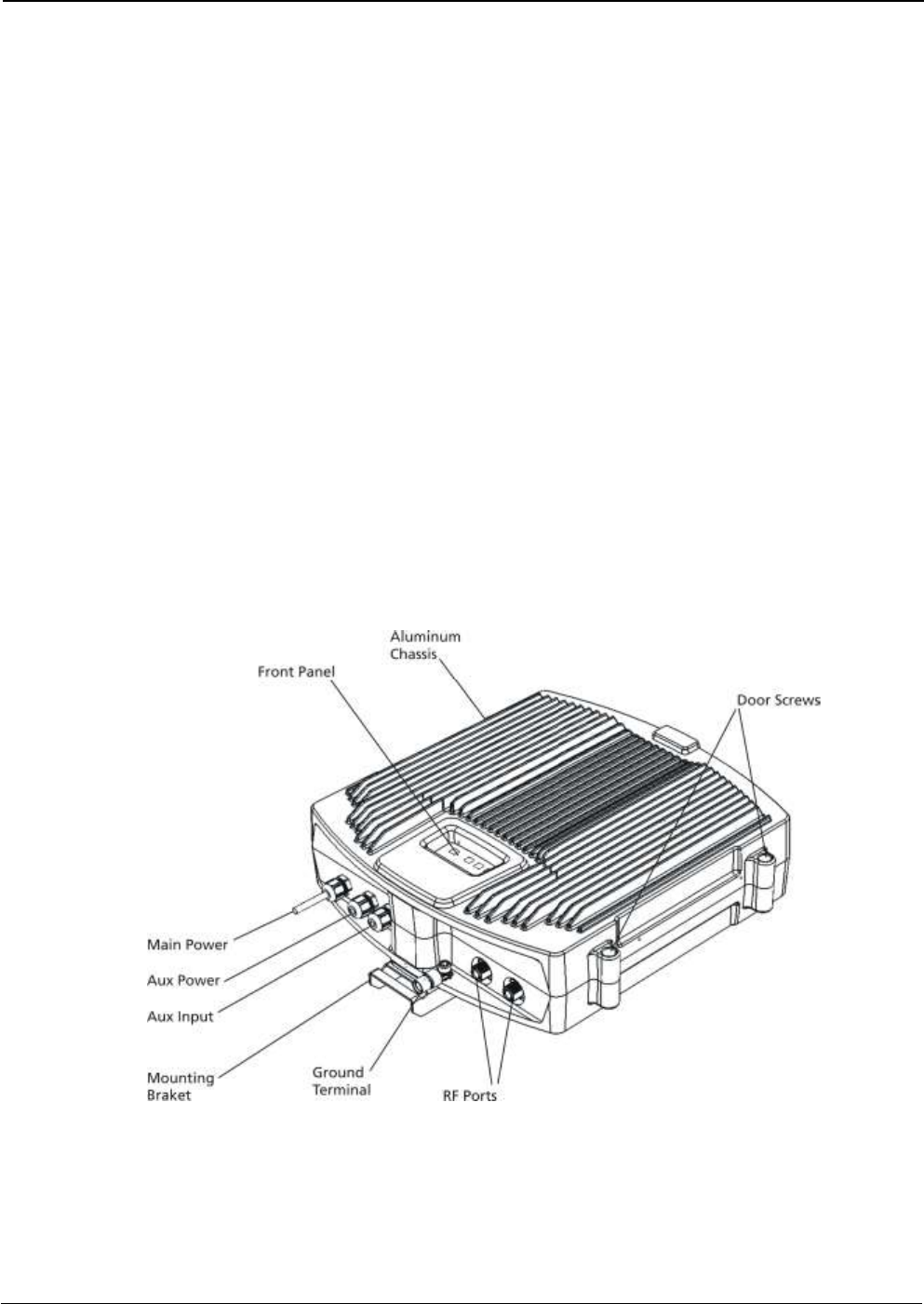
UM-0825 9
2. Product Description.
The H7 Series Compact Signal Booster are IF SAW based Adjustable Bandwidth signal boosters that operates
in the downlink frequency of 763-775MHz and in the uplink frequency of 793-805MHz for United States. For
Canada it operates in the downlink frequency of 768-776MHz and in the uplink frequency of 798-806MHz.
This Signal boosters extends the radio coverage into areas inside the Base Station range where propagation
losses prevent reliable communication.
The system receives the UL signal though a Donor antenna to be amplified, filtered and re-radiated through
the Service antennas. The DL signal is received by the Service antennas to be amplified, filtered and re-
radiated through the Donor antenna back to the Base Station. This way, the system works as a Bidirectional
Amplifier.
This signal booster is capable of handling one Adjustable Bandwidth band from 700KHz to 12Mhz in uplink
and downlink. The start and stop frequency can be tuned via a software interface.
The intermediate filtering of this equipment is performed using IF SAW filtering technology and, among many,
it has the following features:
- High Selectivity.
- Adjustable BW filter.
- Uplink Squelch with configurable threshold and configurable time hysteresis.
This Digital Signal Booster has a compact heavy duty IP67/NEMA4X cabinet for outdoor usage, it is designed
to be wall or pole mounted.
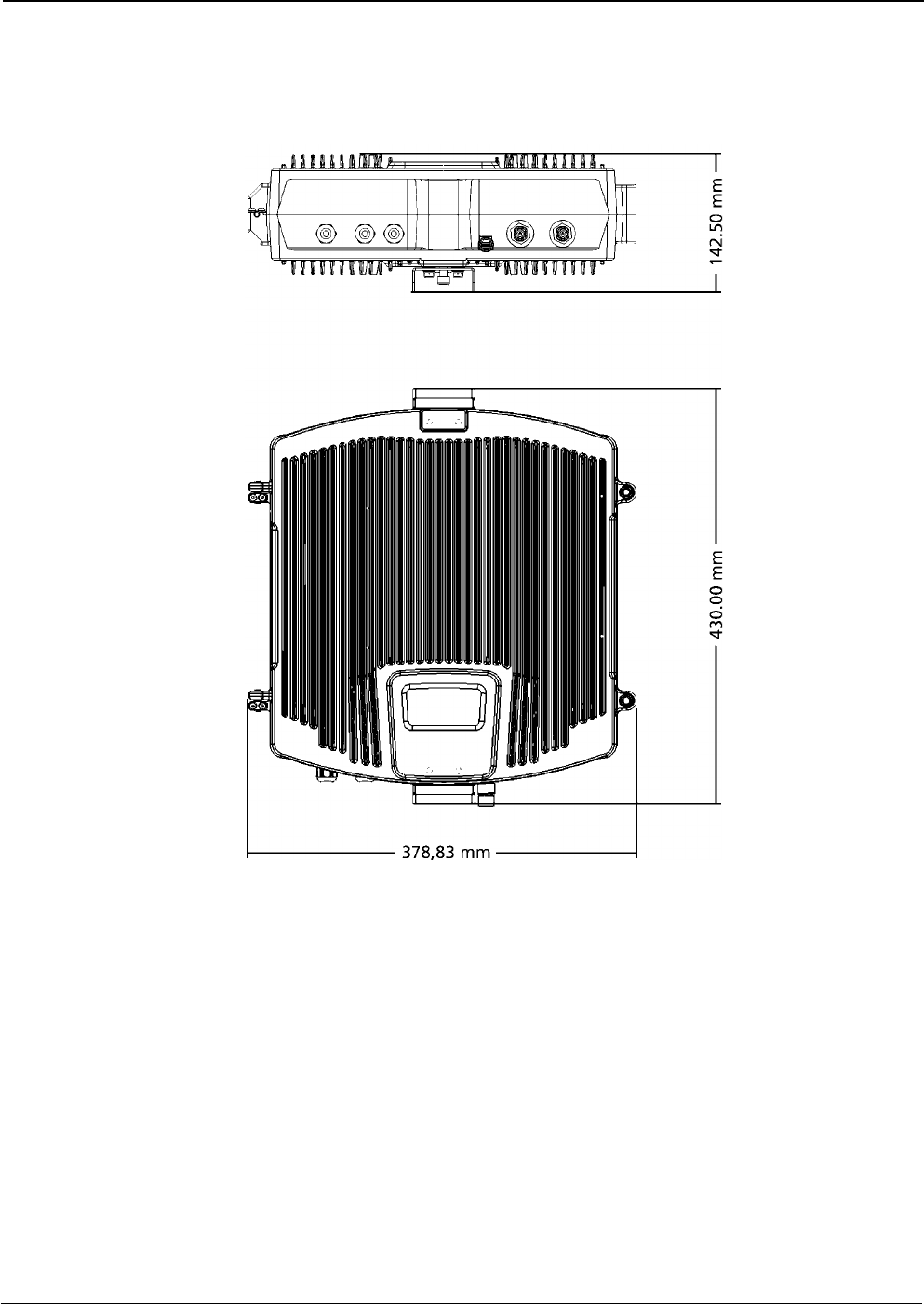
UM-0825 10
Dimensions
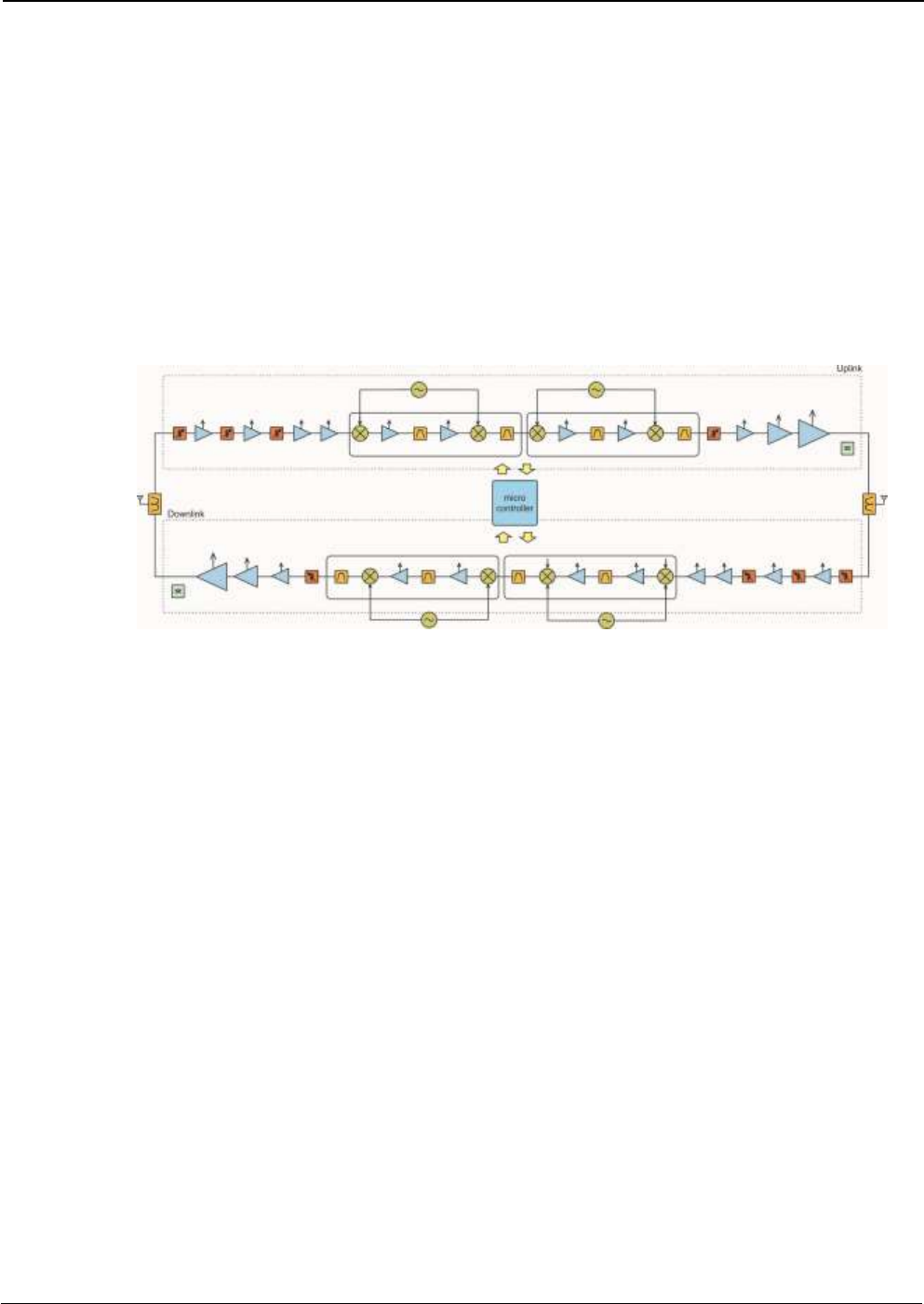
UM-0825 11
3. Signal Booster Block Diagram
This Signal Booster is basically a bi-directional amplifier, the downlink signals are received by the Signal
Booster from cell site by the donor antenna, filtered by its internal duplexers and IF filters units, amplified by
low noise amplifier(LNA) and downlink PA unit, and then sent via the server antenna to the area to improve
mobile signals for mobile phones.
The uplink signal of mobile devices from the coverage area is input via the server antenna, then filtered by
duplexers and IF filters units, amplified by the uplink low noise amplifier (LNA) and the uplink PA unit and
finally sent via the donor antenna to the cell site tower.
A detector in the PA stage measures continuously the output level. The signals from this detector is used
by the automatic gain control(AGC), to supervise and, if necessary, reduce the chain gain, in order to keep
the output power level, under the maximum.
All the parameters are supervised by a microcontroller.
4. Installation
Mounting the Signal Booster
The Fiplex Compact Signal Booster is designed for outdoor usage with a weather proof outdoor cabinet
that can be mounted without any kind of shelter from rain, snow or hail.
However, to improve reliability, it is recommended to mount the Signal Booster on a site with some kind of
shelter from direct exposure to sun, rain, snow and hailing.
We extremely recommend not operating the Signal Booster under very bad weather conditions, such as:
- Intense rainfall, snowfall or hail
- Storm or high wind
- Extremely low or high temperature
- High humidity of the air
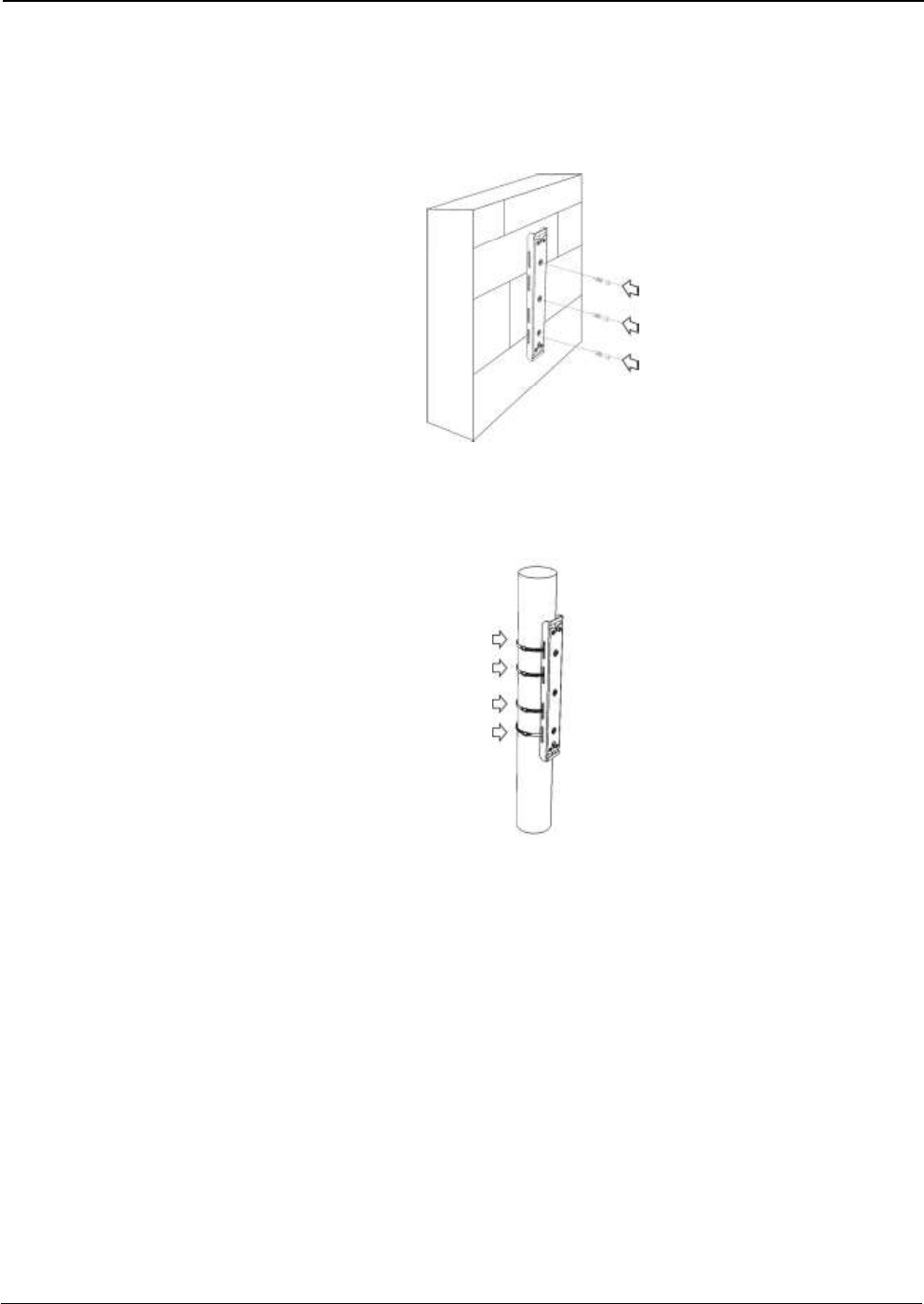
UM-0825 12
Mounting
1. Mount the bracket
The Signal Booster can be mounted on a wall or pole. These mounting cases are shown below in Figure 1
and Figure 2. The bracket is provided with the Signal Booster.
Figure 1
Figure 1 shows a bracket attachment to a wall using three fixing screws.
Figure 2
Figure 2 shows a bracket attachment to a pipe using two inox hose clamps (provided with bracket).
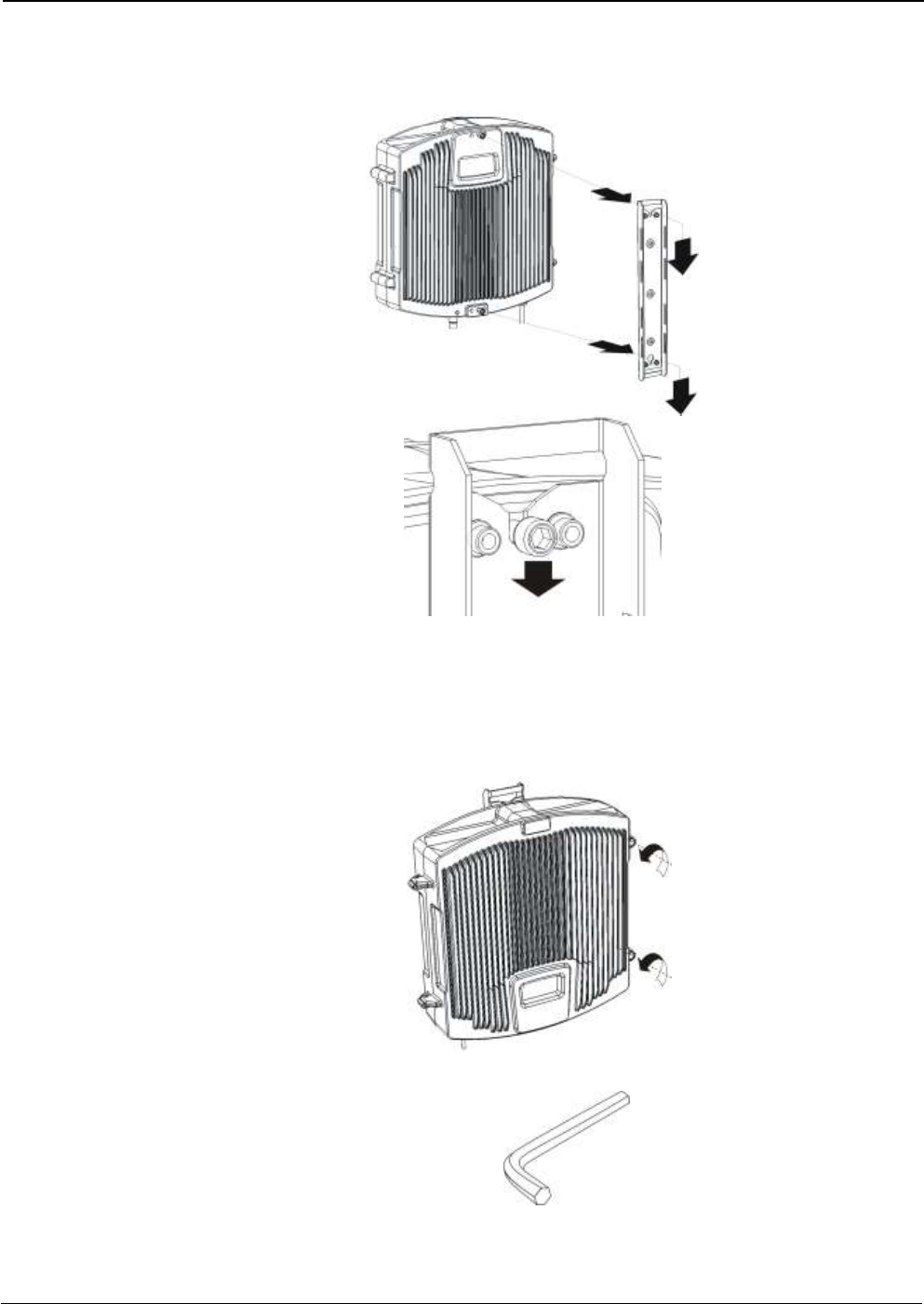
UM-0825 13
1. After attaching the bracket hang the Signal Booster.
Figure 3
2. Screw the cabinet to the bracket
To attach the Signal Booster’s cabinet to the bracket use the provided four M6 x 2” allen screws and follow
the indicated steps:
A - Release Signal Booster cover.
Use allen key N°6
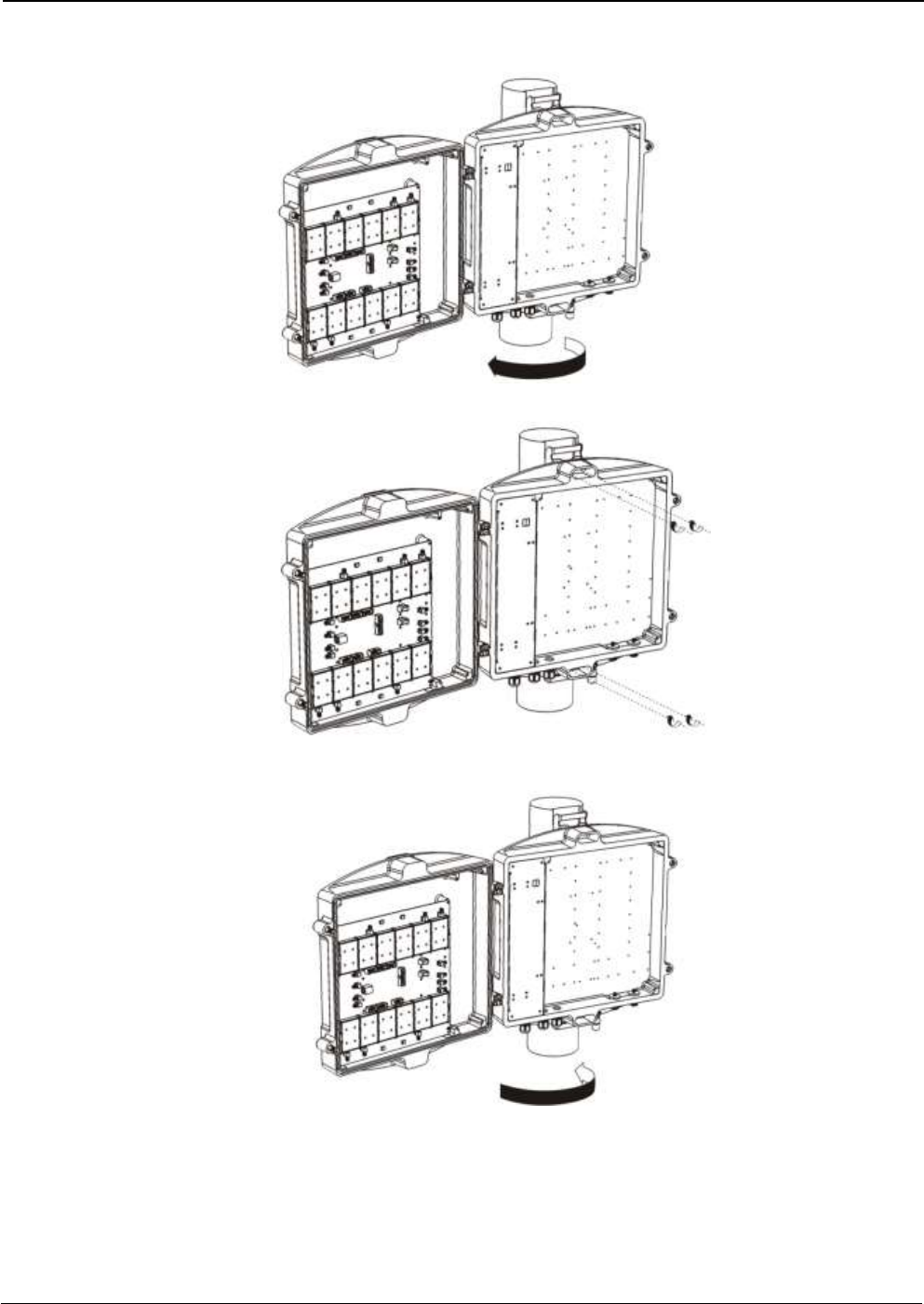
UM-0825 14
B - Open Signal Booster cover.
C - Place and screw the four M6 x 2” allen screws.
D - Close the cover.
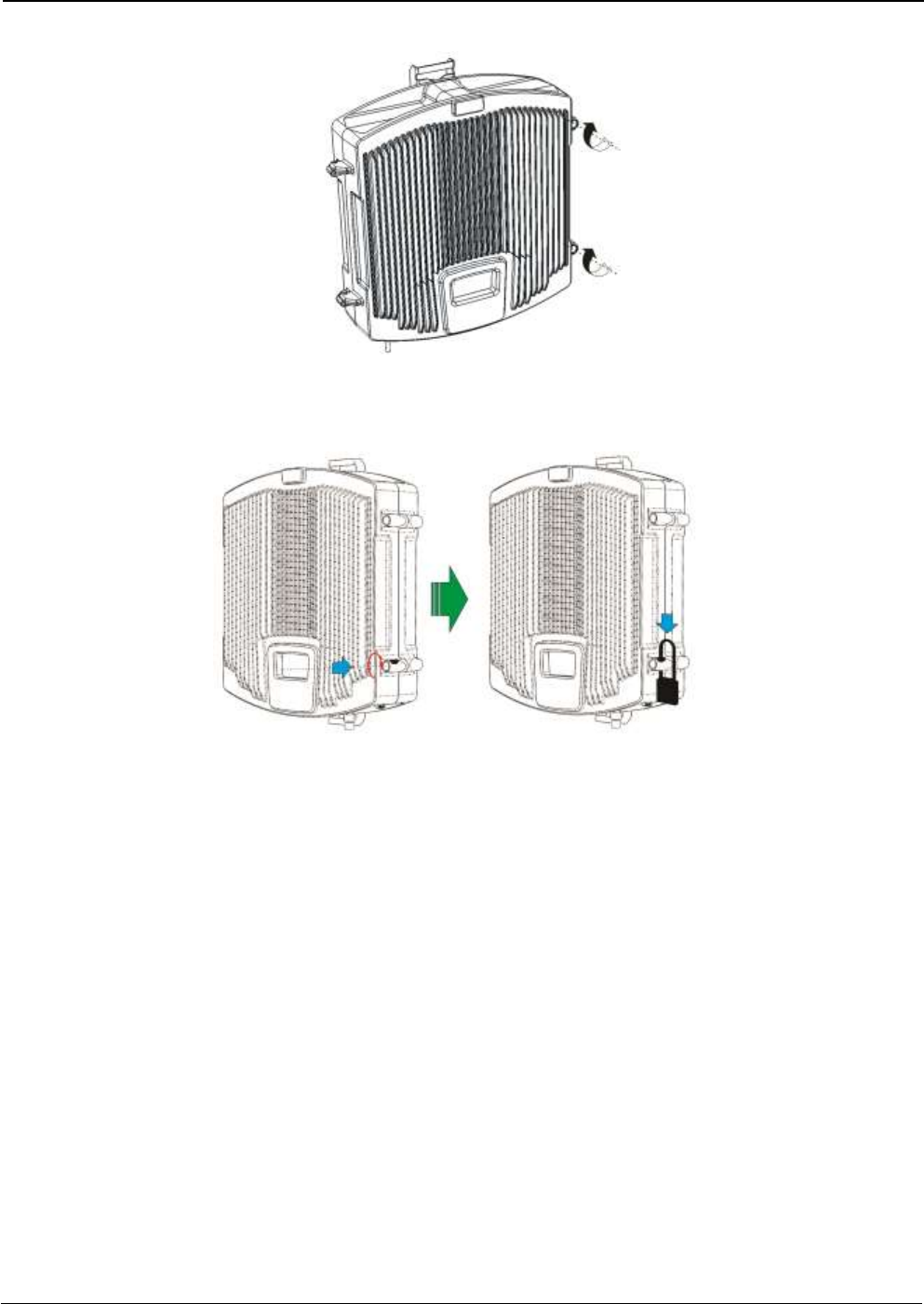
UM-0825 15
E - Secure Signal Booster
If additional security is required, you can lock the cabinet with a padlock. For this, secure the locking pin and turn the lock as
shown in the figure.
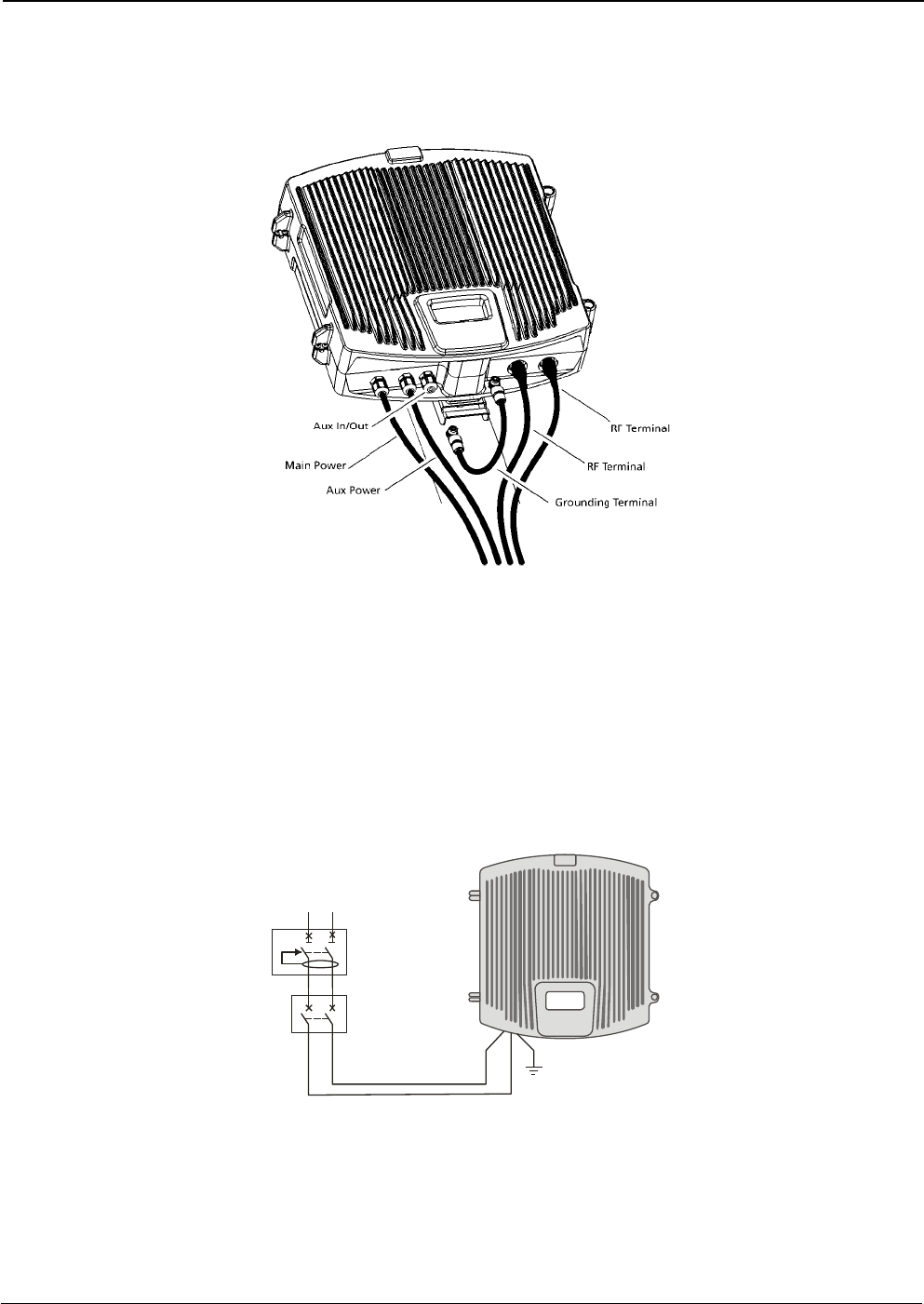
UM-0825 16
Commissioning
Figure 4
Figure 5 shows RF ports and AC and DC cable glands location.
1. Connect service antenna (“TO MOBILE” port) and donor antenna (“TO BASE” port) coaxial cables. N
type female connectors are used in the Signal Booster.
2. Once RF ports of the Signal Booster are properly loaded connect mains to the AC source.
Electrical installation must provide differential and termo-magnetic breaker elements according to electric
safety international regulations.
3 Make sure that not used cable glands are properly sealed. For this, use the seal plug and self-
amalgamating tape.
L N
TMB
DB
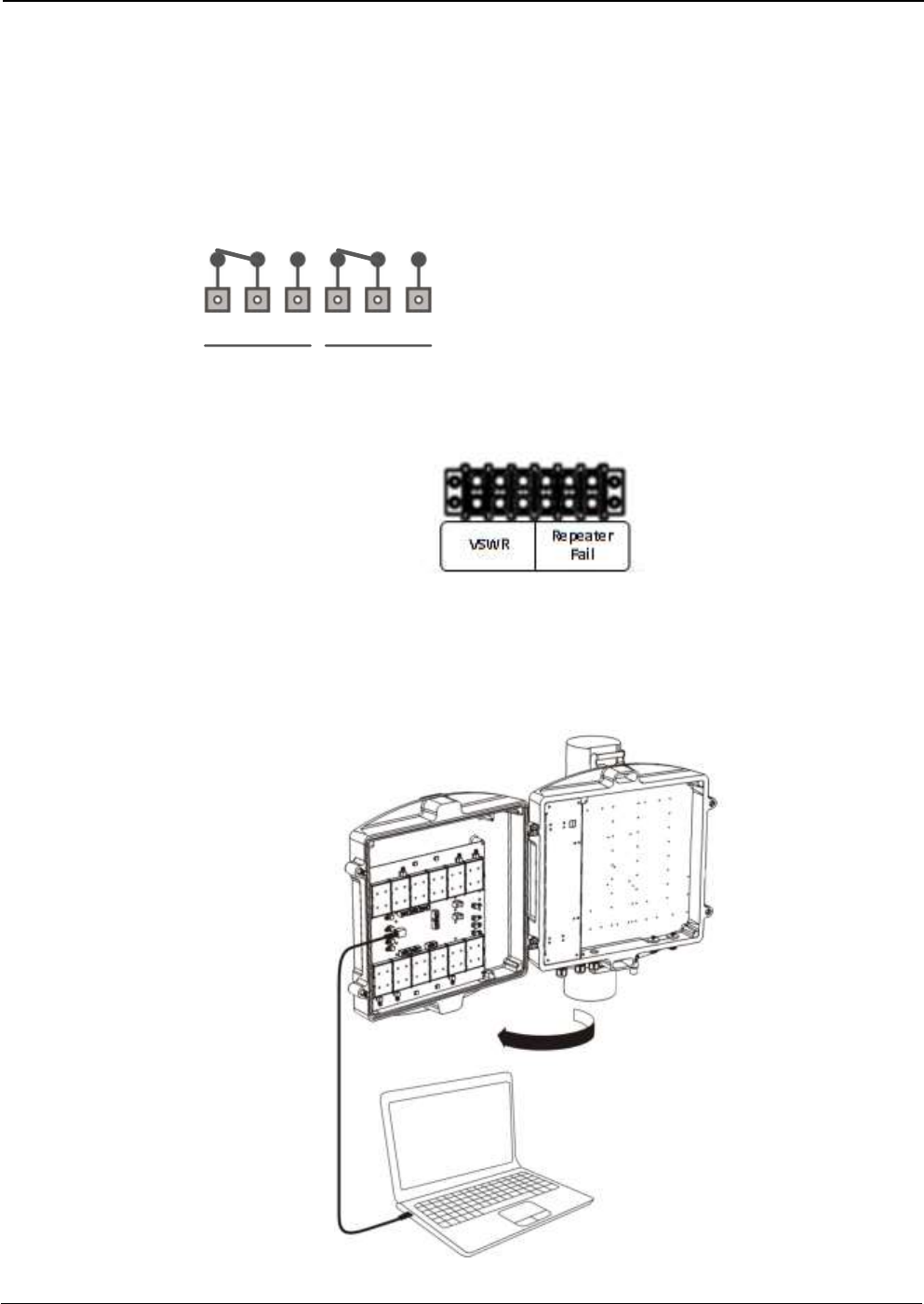
UM-0825 17
3. Auxiliary DC connection can be provided to the Signal Booster from an external DC source.
There is a dedicated cable gland for this purpose (EXT DC INPUT in figure 4), and a dedicated DC connector
labelled P60002 located at the main board. A 5.5mm x 2.1mm center positive plug must be used.
Please check appropriate DC voltage at Signal Booster specification sheet.
4. If the Signal Booster has the NFPA Option, there is a dedicated cable gland for this purpose (“AUX IN/OUT”
in figure 4). A multi-conductor cable can be used to connect the NFPA dry contacts to the Fire Department
Control Box.
Figure 5; NFPA Dry Contact connection configuration
Figure 6; NFPA Dry Contact connection location inside the cabinet
5. Once the Signal Booster has been connected to power source (either AC mains or external DC), it takes
about 20 seconds to run a booting routine. After that time Signal Booster is ready to be connected via USB
cable to a computer running pFOMS in order to be properly configured.
See Part 2 Software of this manual to install pFOMS.
456123
NC NO NC NO
Repeater
Fail
VSWR
Status of contacts (Alarms Off)
Pin 1 – 2 = VSWR (normally closed contact)
Pin 2 – 3 = VSWR (normally open contact)
Pin 4 – 5 = Repeater Fail (normally closed contact)
Pin 5 – 6 = Repeater Fail (normally open contact)
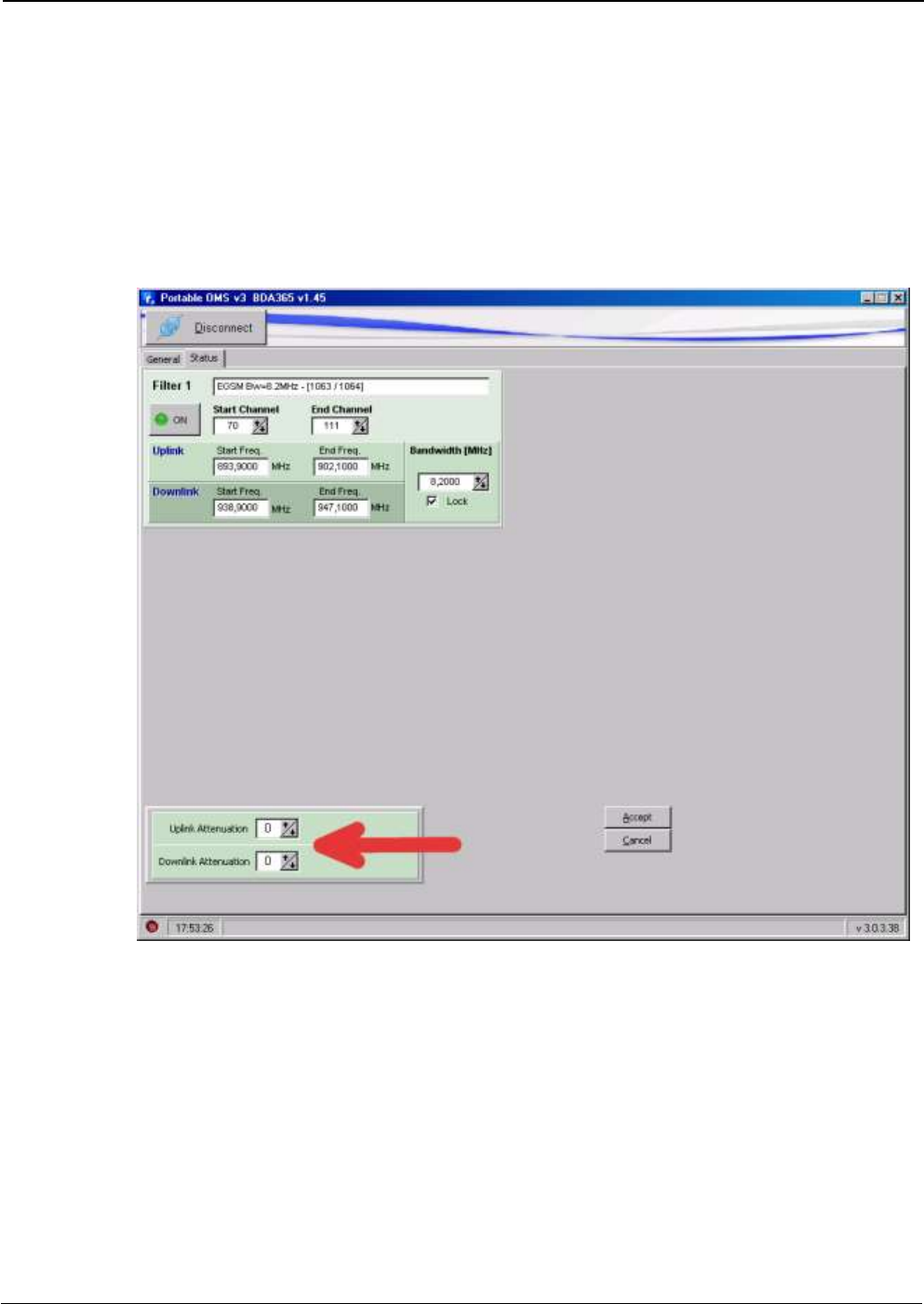
UM-0825 18
Starting operation
1. Setup desired filter configuration using pFOMS (only for programmable band selective and
programmable channel selective models).
For fixed bandwidth Signal Boosters this feature will not allow user to make changes, so, skip this step for
fixed bandwidth models.
2. Setup desired operating gain using pFOMS. UL and DL chain are independent, so both values must be
set.
For nominal gain of the Signal Booster these values must be set to zero.
Figure 7
Figure 7 shows how to set up manual attenuation values.
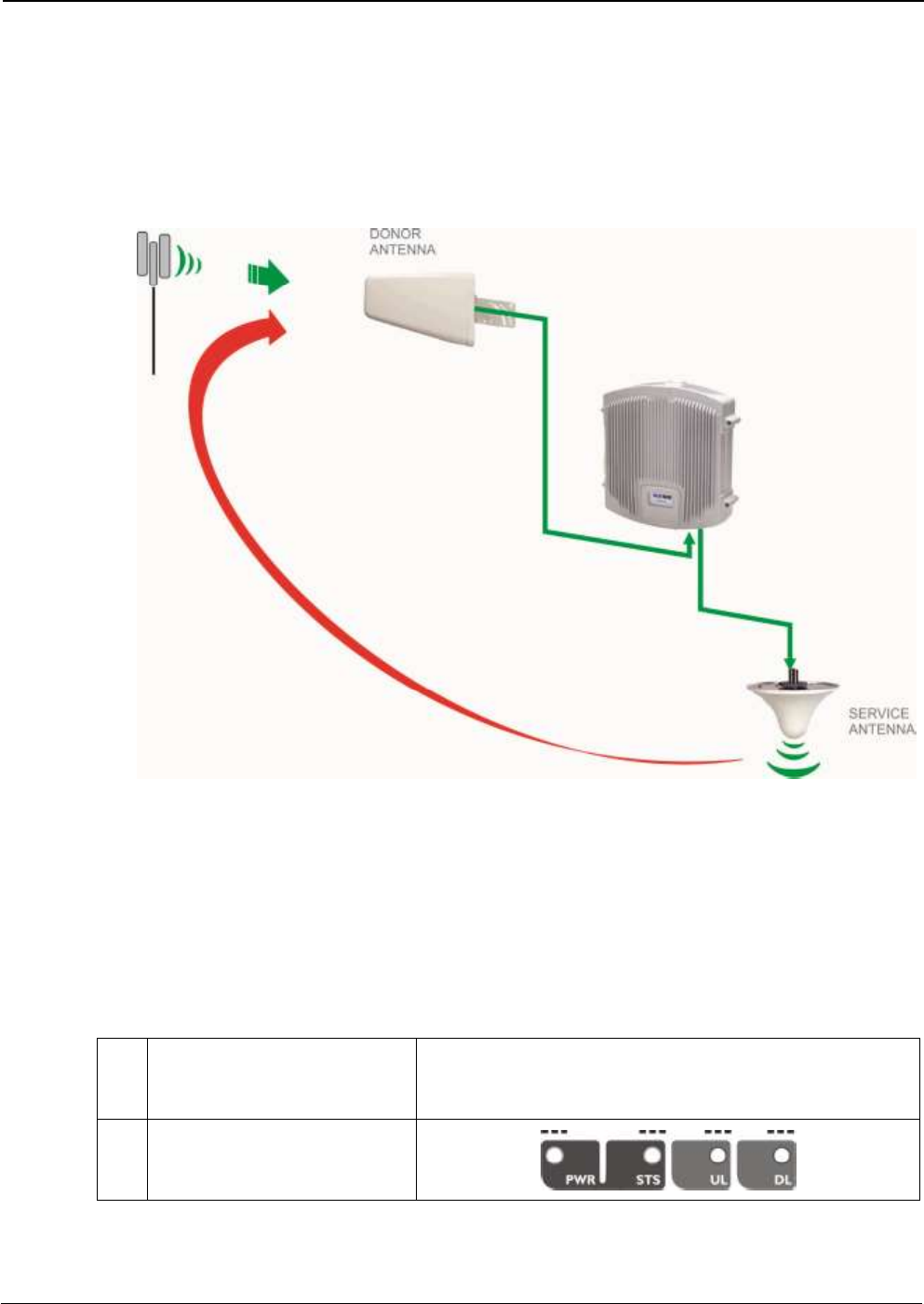
UM-0825 19
Auto-oscillation Condition
If the isolation between donor and service antennas system is lower than required, the amplified signal will
go back from service antenna to donor antenna. It will lead to self-oscillation, reducing the coverage area
and amplified signal quality.
The isolation between donor and service antennas systems must be, the nominal Signal Booster gain plus
15dB, in order to assure the properly operation of the Signal Booster.
.
Status Indicators
There is an indicator panel located at the front panel of the Signal Booster. This led panel works as a status
monitor, in order to advice different operational conditions of the Signal Booster.
There are four leds, first one the power ON indication led, labelled “PWR”.
A Second led, labelled “STS” resumes warnings regarding critical operational conditions of the Signal
Booster.
Third and fourth led resumes operational conditions for uplink “UL” and downlink “DL” chains.
Signalling will be explained in table 1.
Operative Condition
Indicator Panel
1
Start UP
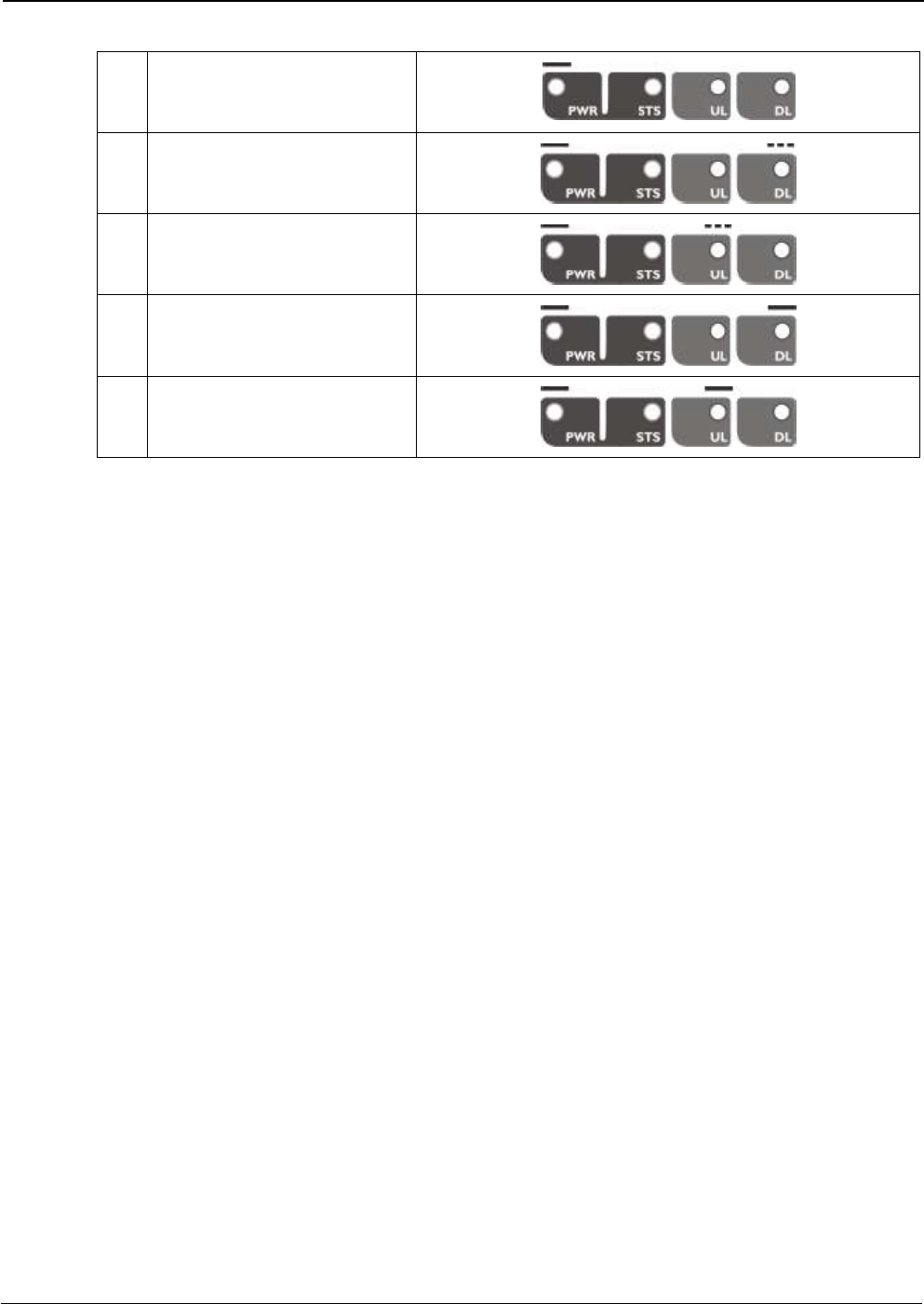
UM-0825 20
2
Stationary state
3
AGC DL
4
AGC UL
5
Overload DL
6
Overload UL
Table 1
1. Start UP
Every time the Signal Booster is plugged to AC mains (or auxiliary DC power), will start a self diagnosis and
booting sequence that lasts around 20 seconds, during this time Signal Booster is not available for traffic,
and the reason is because an automatic antenna isolation control procedure runs in order to detect poor
isolation conditions. During this time all leds in the front panel will blink.
In case of bad isolation condition led “UL” or “DL” (depends on the path where auto-oscillation condition
was detected) will stay ON during five seconds.
2. Stationary state
Once the booting sequence is finished and under no AGC or Overload conditions only the PWR led must
keep ON.
3. AGC DL
Blinking condition indicates that AGC circuitry is active for downlink path. For further information
please read Automatic Gain Control (AGC) latter in this chapter.
4. AGC UL
Blinking condition indicates that AGC circuitry is active for uplink path. For further information
please read Automatic Gain Control (AGC) latter in this chapter.
5. Overload DL
Led permanently ON indicates that Overload protection circuitry for downlink path is active.
For further information please read Overload Protection latter in this chapter.
6. Overload UL
Led permanently ON indicates that Overload protection circuitry for uplink path is active.
For further information please read Overload Protection latter in this chapter.
Automatic Gain Control (AGC)
Automatic Gain Control circuitry is intended to keep Signal Booster’s output power at a fixed level when input
signals exceed maximum values, avoiding quality signal degradation by intermodulation generation.
When AGC is active AGC leds from UL or DL (or both) will blink, this means that signal level from donor site
(or from service area) plus Signal Booster gain produces an output power that is above the maximum
composite output power of the Signal Booster. This should not be considered an undesired working condition,

UM-0825 21
far from that; this is the best operating condition because you are getting the maximum composite output
power available from the Signal Booster.
Anyway is a good practice to increase attenuation (reducing gain), until AGC led turns off, this operation
releases AGC circuitry dynamic range.
Also is a good practice to check signals from donor site to ensure that undesired signals are not being
amplified by the Signal Booster, or even desired signal levels are not excessively high taking Signal
Booster to an overload condition.
Overload Protection
When AGC circuit reaches its limit, the power amplifier stage is shut down to prevent harmful distortion and
potential damage to the Signal Booster. After approximately ten seconds the system checks if overload
condition is still present, if this happens amplifiers will remain off. This cyclic check will continue until condition
that makes AGC circuitry reach its limits disappears.
Conditions that can cause AGC to reach its limits include the presence of one or more very strong channels,
a strong in-band noise source, or amplifier oscillation due to poor antenna isolation.
When overload protection lower row led from UL or DL (or both) will be ON permanently.
Laboratory Measurements
For specific parameters verification and laboratory tests, please contact factory.
Detailed procedures, recommended tests set up, and a knowledge engineering team will bring adequate
support to perform this measurements in a comfortable and safely way.
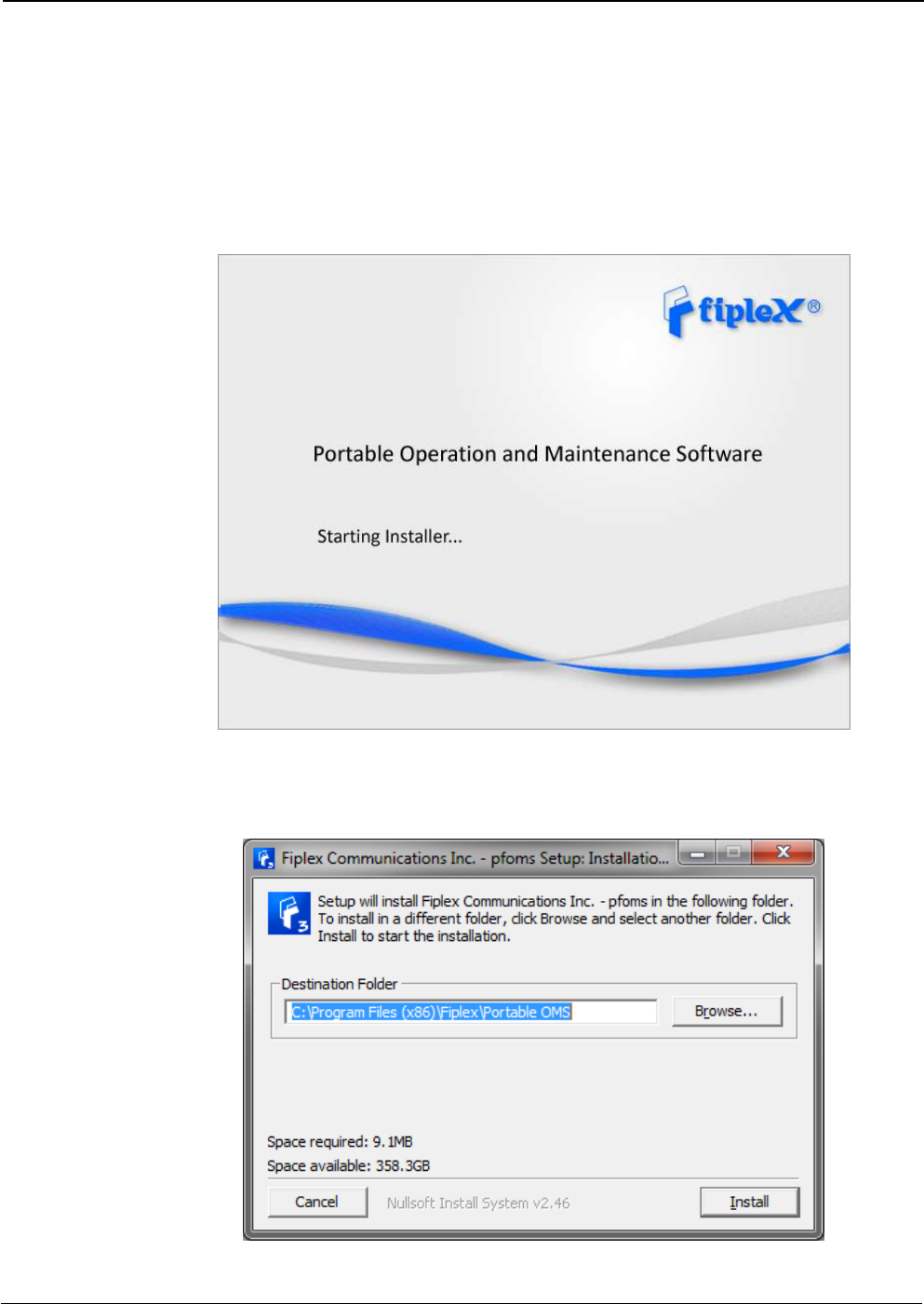
UM-0825 22
Part 2 SOFTWARE
5. Installation
The following section will describe the steps to be followed in order to install and use the pOMS
software with your Fiplex Signal Booster.
1. Run the FiplexPomsInstaller.exe File. A splash screen will appear…
2. Choose the default installation path “C:\Program Files (x86)Fiplex\Portable OMS”. Note that
this can change according to your system configuration (32bits or 64bits), language and
Windows Version.
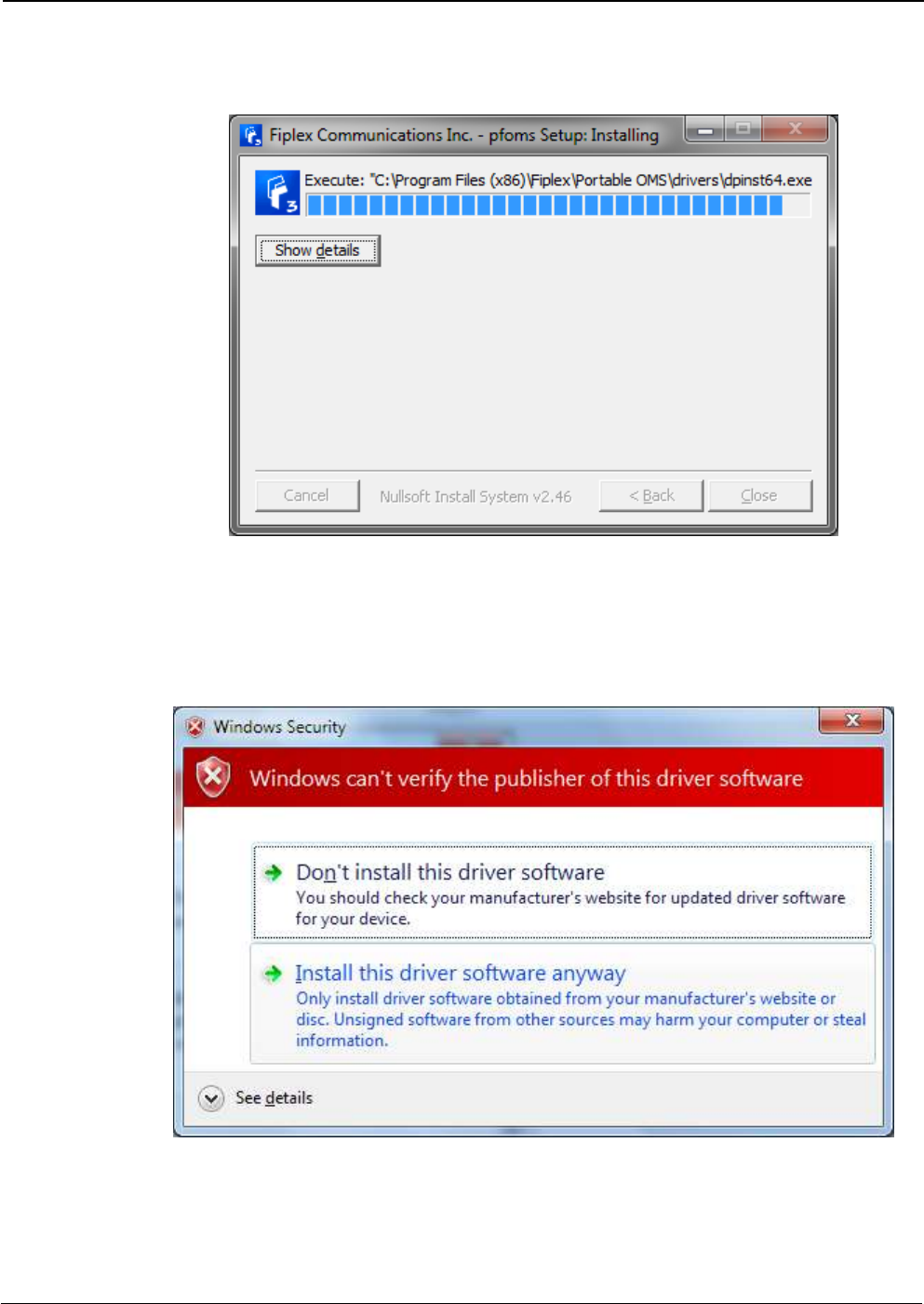
UM-0825 23
3. The installer will start to copy the necessary files.
4. Following this, the installer will attempt to install the device driver. According to your windows
configuration, a screen like the following can appear. This indicates that you are going to
install a not official windows driver. Choose to install the driver software anyway.
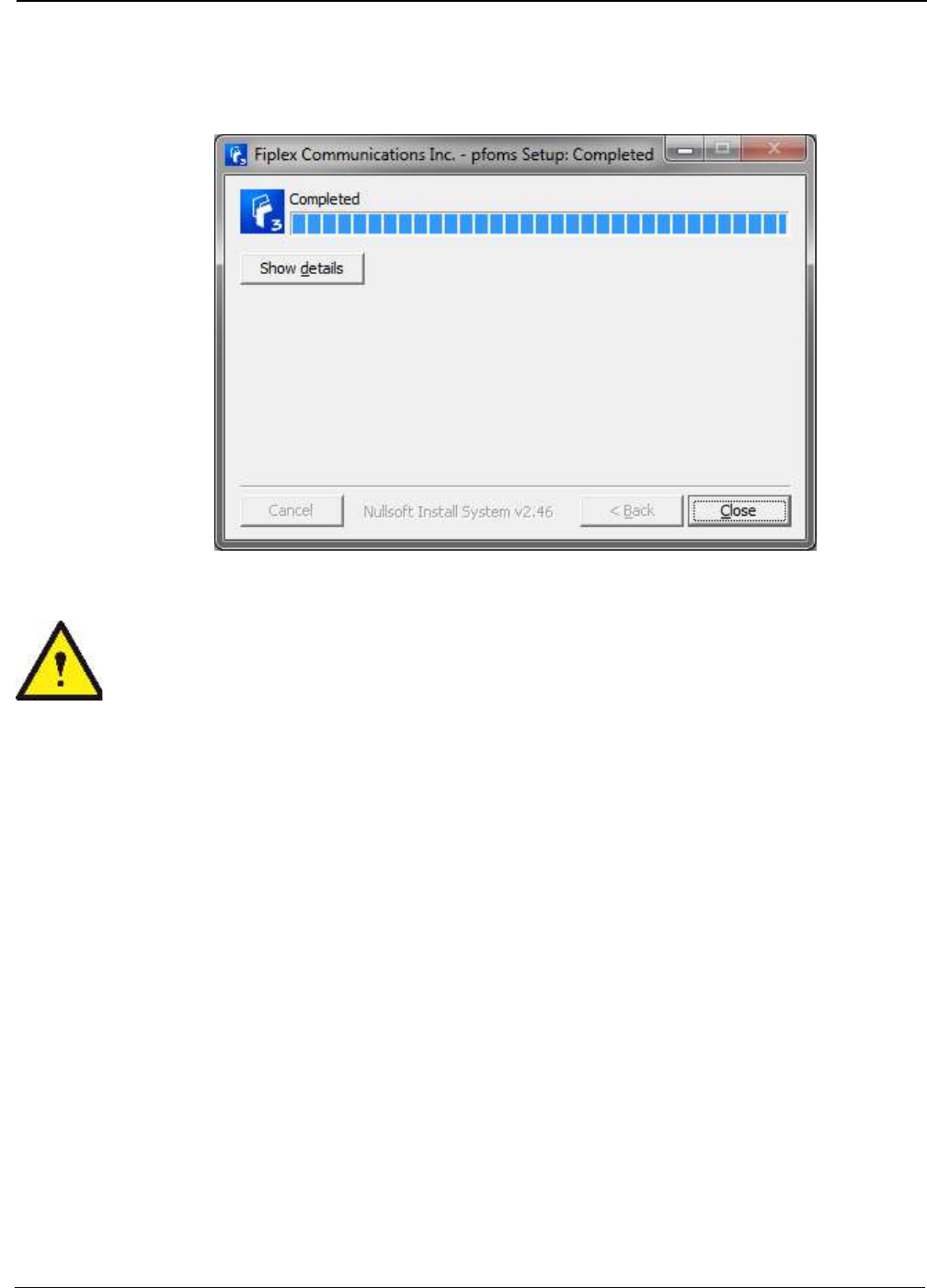
UM-0825 24
5. Now you can watch the details of the installation or simply close.
6. Turn on the Signal Booster
BE SURE THAT “TO MOBILE” AND “TO BASE” PORTS ARE PROPERLY LOADED EITHER
WITH 50 OHMS DUMMY LOADS, OR RADIATING SYSTEM.
7. Plug in USB cable to USB male connector labeled as “COMM”. If the driver is installed
properly you should see a new COM port in your device list.
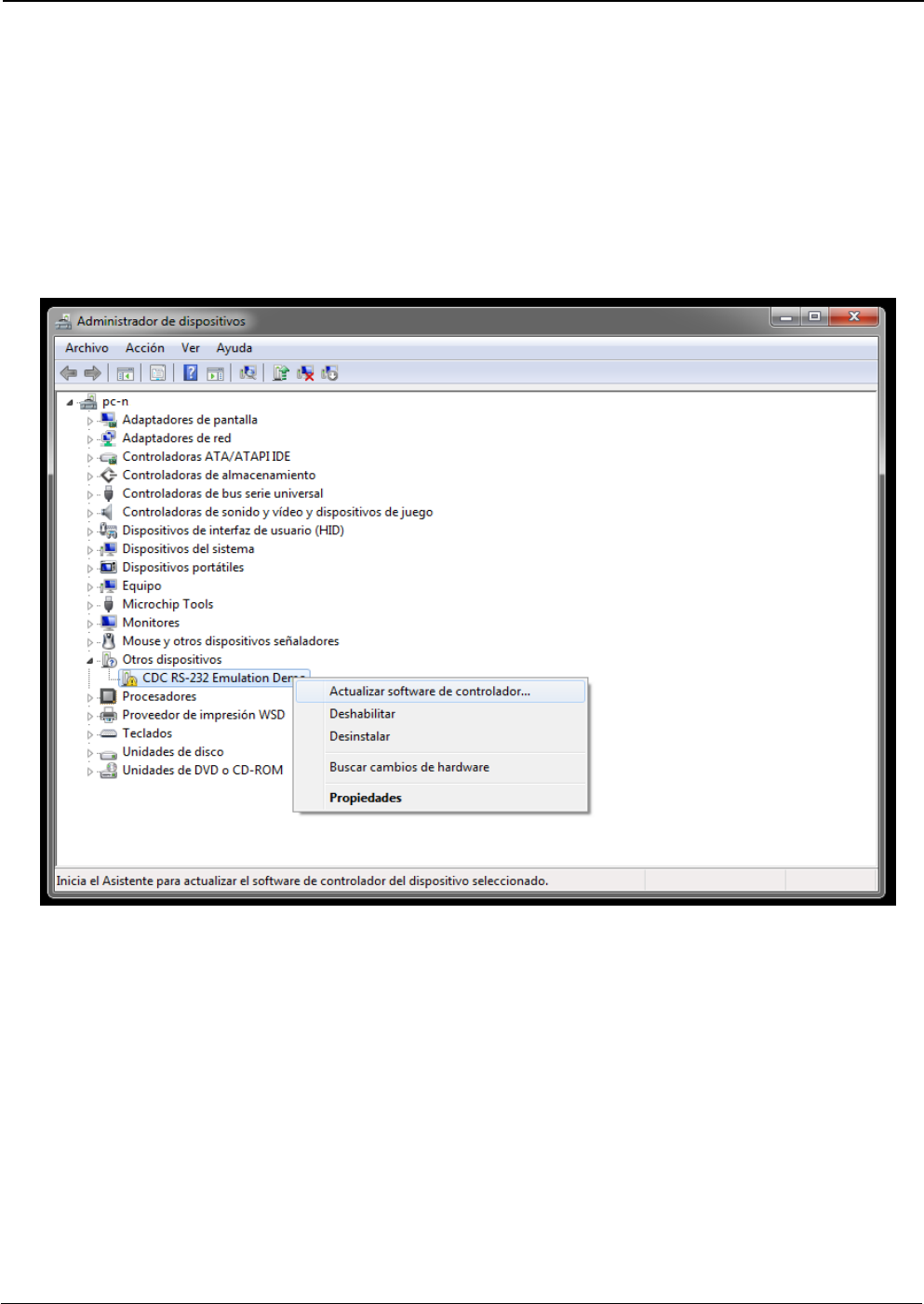
UM-0825 25
6. Software Installation Troubleshooting Guide
6.1. Driver installation failure
If the automatic driver install process fails for some reason, you can do it manually. You must
have your PC connected via USB to your Fiplex nano Signal Booster.
Open your Control Panel and then go to Device Manager. You should see a screen like the
following where you can see an exclamation mark indicating that your OS does not have the proper
driver installed.
Right click on it and then choose “Update Driver Software”.
If the automatic driver install process fails for some reason, you can do it manually. You must
have your PC connected via USB to your Fiplex nano Signal Booster.
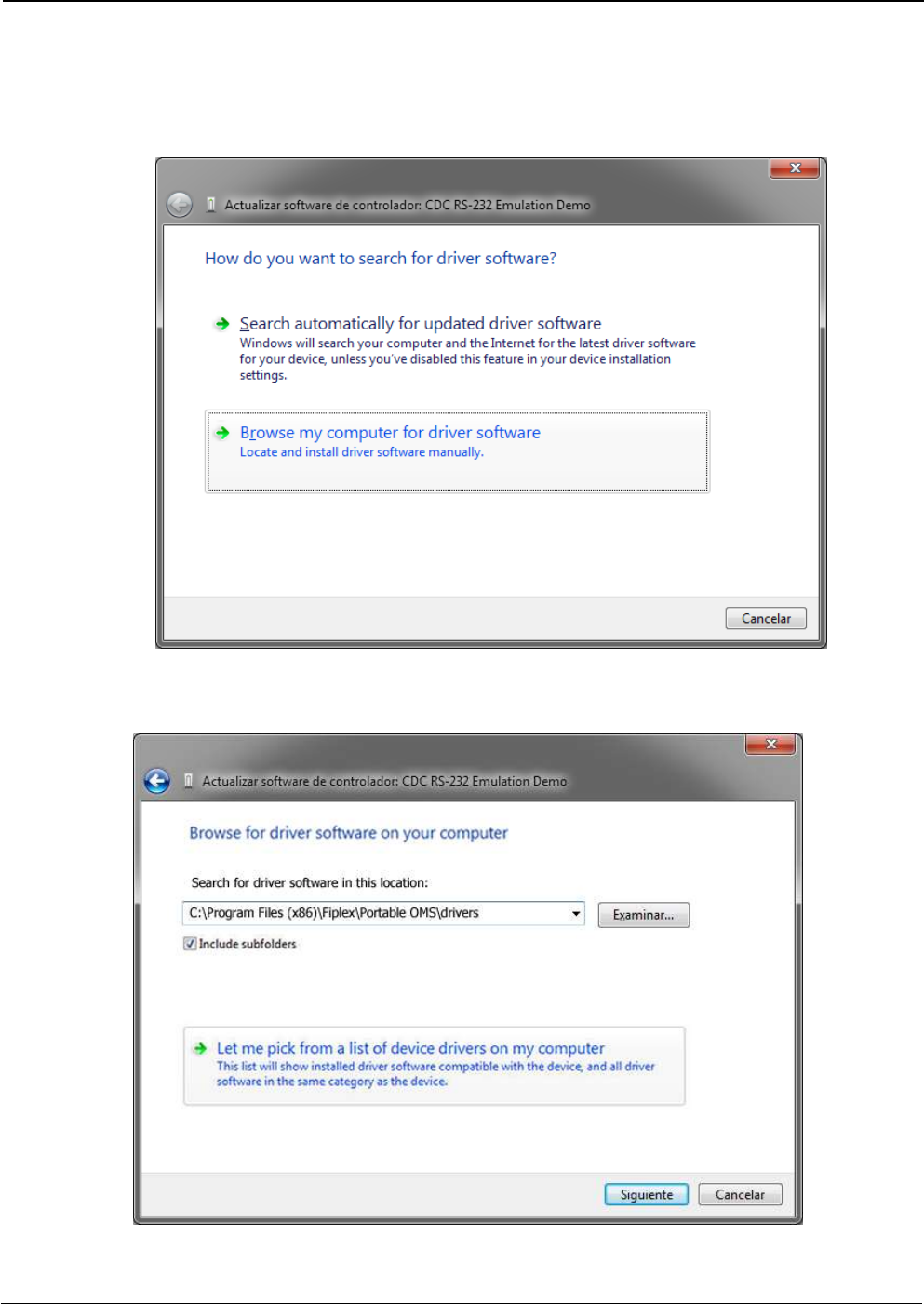
UM-0825 26
Open your Control Panel and then go to Device Manager. You should see a screen like the
following where you can see an exclamation mark indicating that your OS does not have the proper
driver installed.
Right click on it and then choose “Update Driver Software”.
The device drivers are installed in the “drivers” subfolder in your installation path. The next images
shows the default driver location on a Windows 7 64bit.
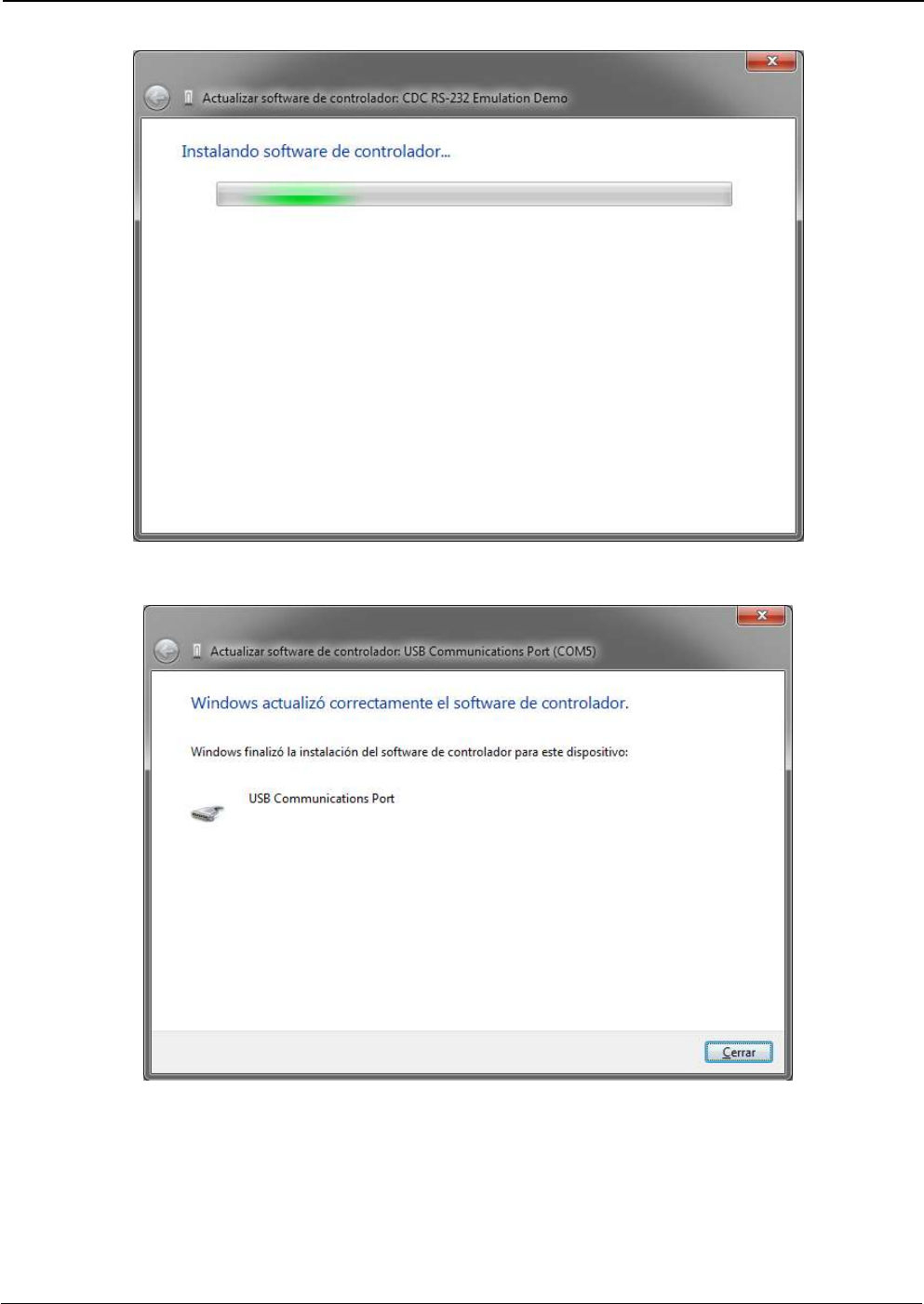
UM-0825 27
If the installation finishes successfully you should have a new USB virtual com port installed on
your PC. The COM number can vary depending on the hardware previously installed in your
system.
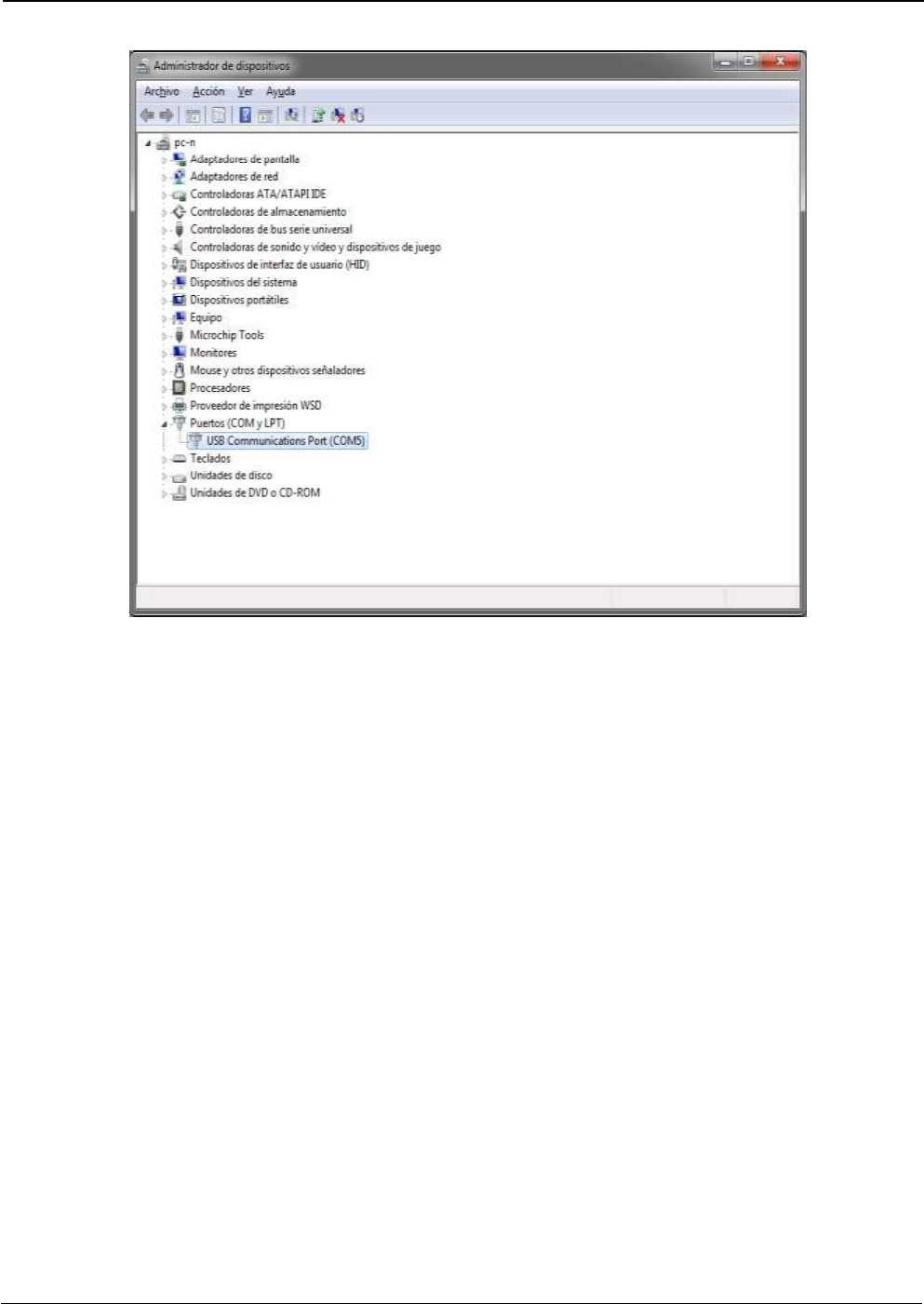
UM-0825 28
6.2. Device Unknown legend in driver.
If you cannot connect to the Signal Booster, and there’s no new COM port installed in your system
after plugging the USB connector to the PC, go to the device manager list.
If there’s a device named as ‘Device Unknown’ that appears and disappears every time you
connect the USB to the Signal Booster, this can be due to problems in the USB cable. Replace it
and try again.
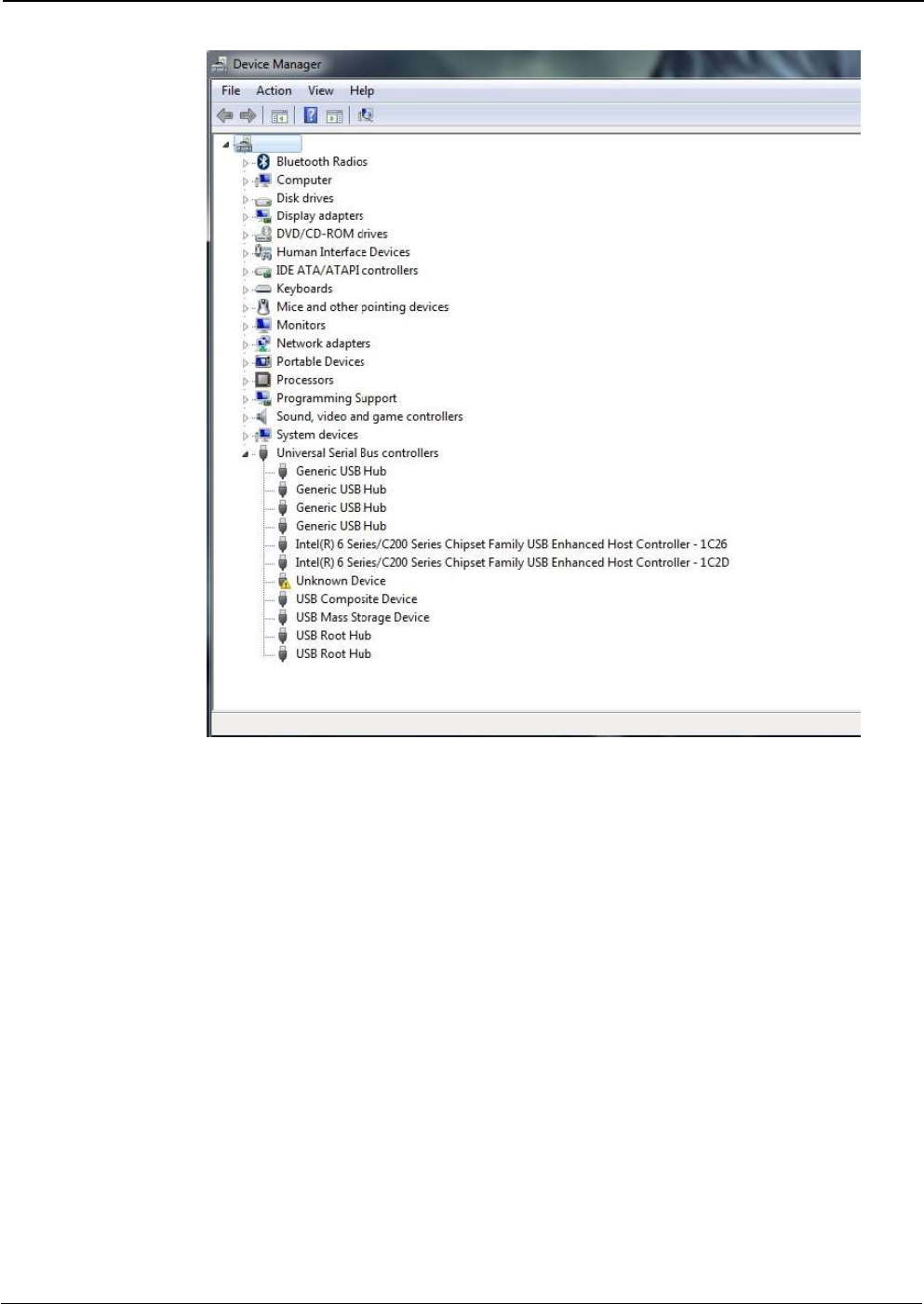
UM-0825 29
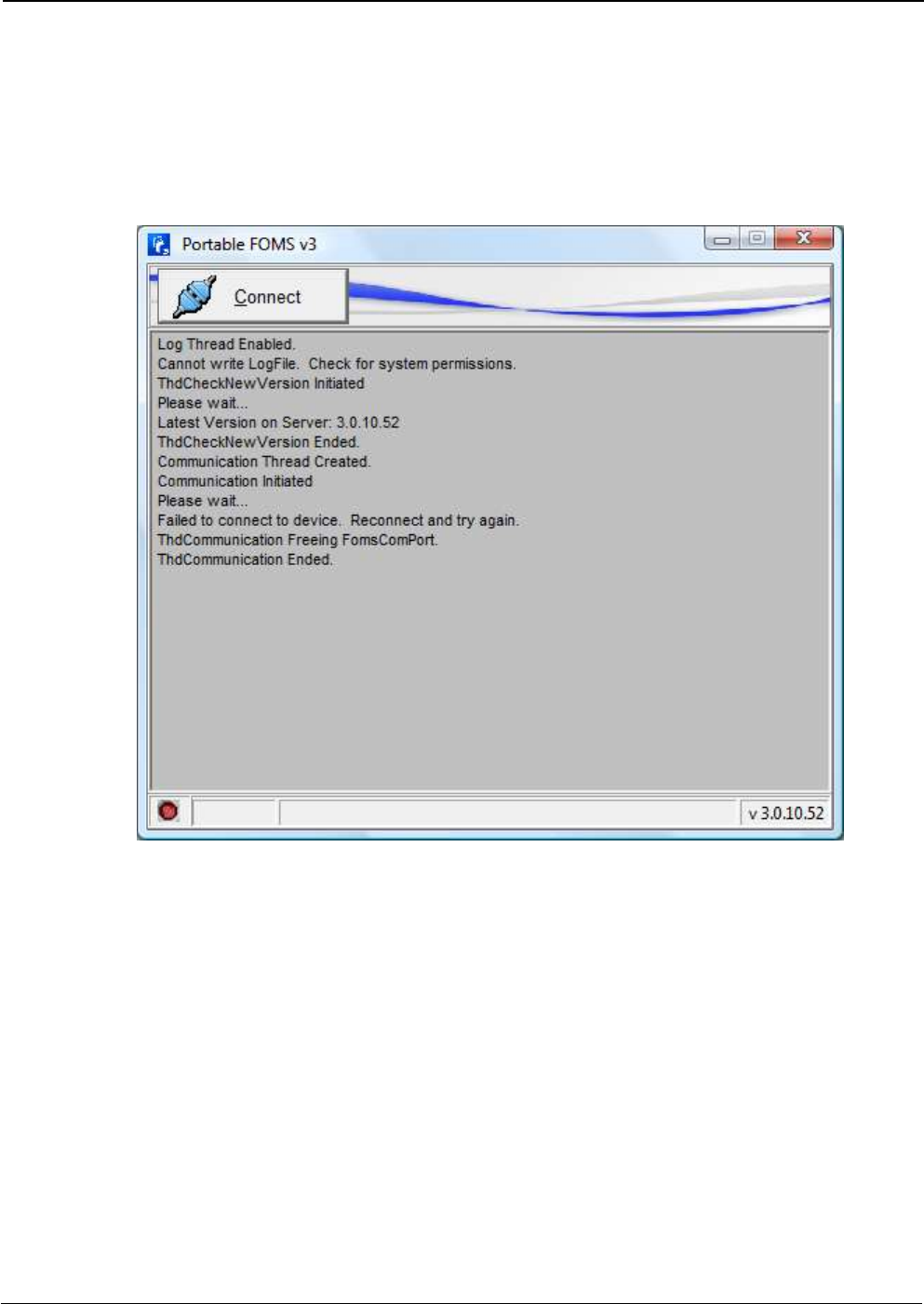
UM-0825 30
6.3. Failed to connect to device
Sometimes the pfoms can inform in the activity box that if Failed to connect to device.
The problem happens to be that the chosen COM port number it is not connected to a Fiplex
Signal Booster.
Solution: Click in connect again and choose the right COM port number. If this doesn’t work, turn
off and on the Signal Booster and try again.
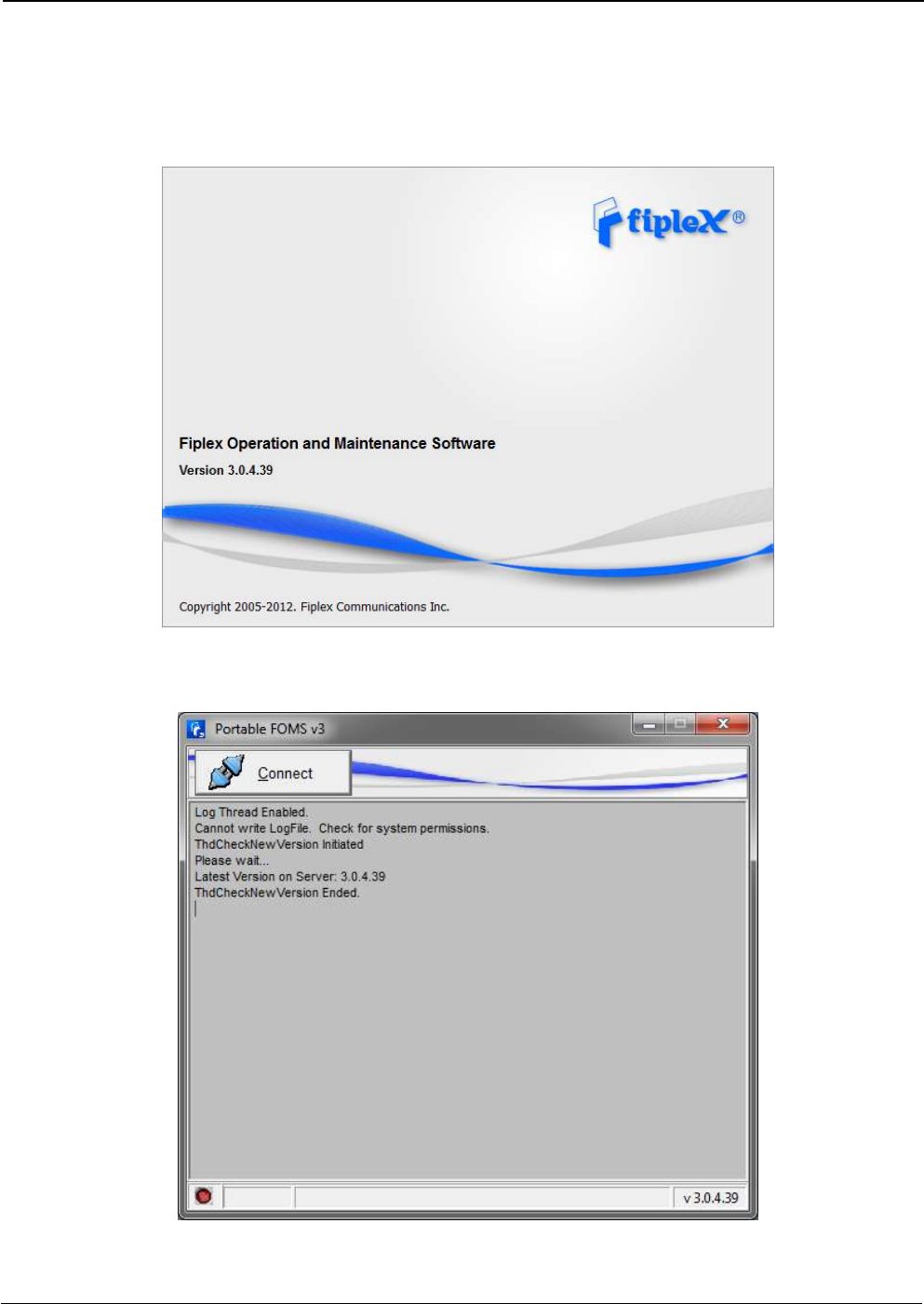
UM-0825 31
7. Using Portable OMS Software
After having installed the CDC-RS232 Fiplex driver, run pFOMS Software.
Click in “Connect”.
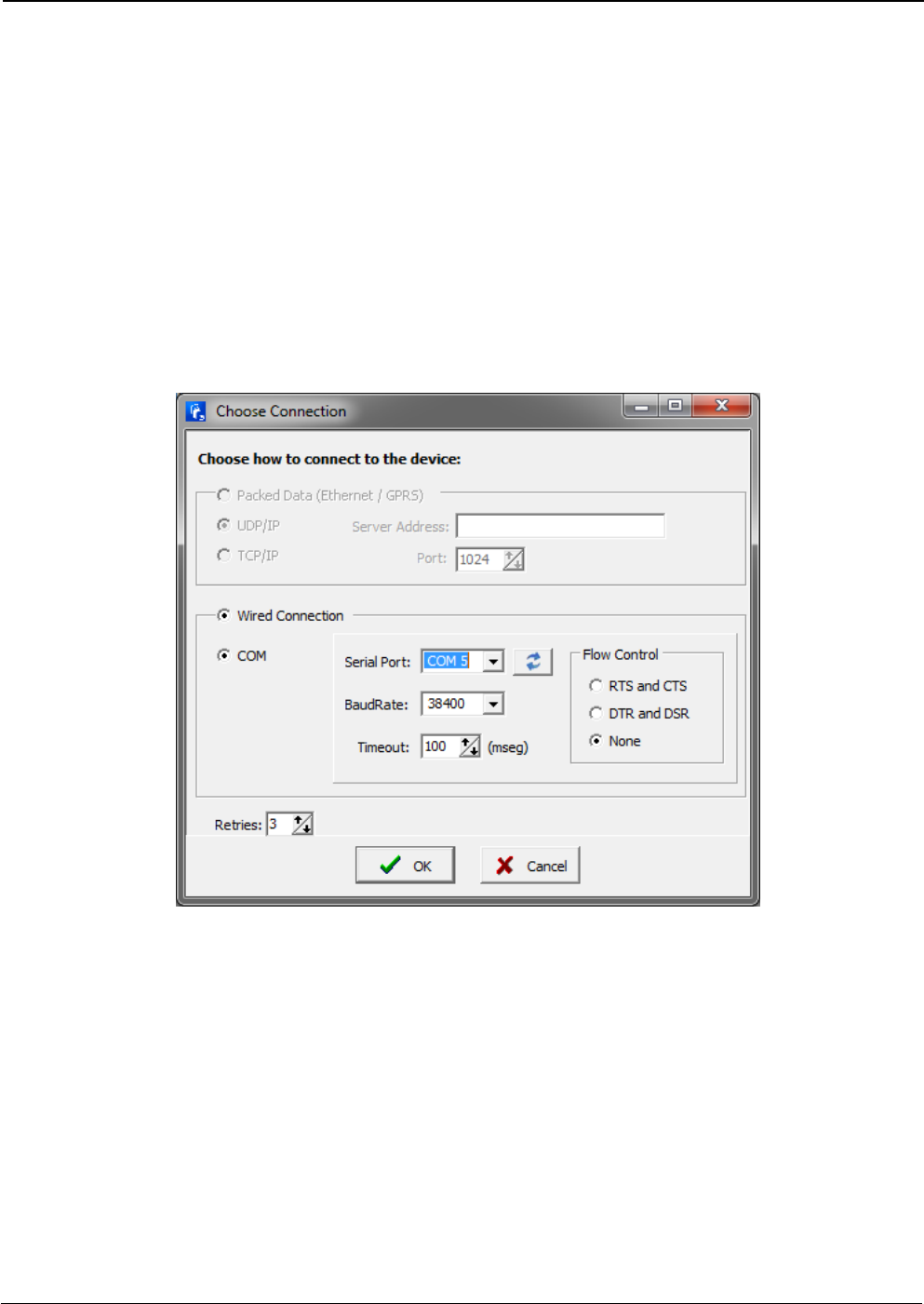
UM-0825 32
Select the serial COM port that just appeared on your PC. Remember that the BDA driver installs
itself as a generic COM port so if properly installed, you should have a new comport not present
before connecting the Signal Booster.
If the Signal Booster is not connected yet you can plug it now to your PC USB connector. The
OMS software should detect the new COM port automatically.
Note that the OMS will show only unoccupied COM ports. If you have more COM ports that are
being blocked by another application they won’t be show in this window.
For this devices Flow control should be set to None.
Click “OK” in order to continue.
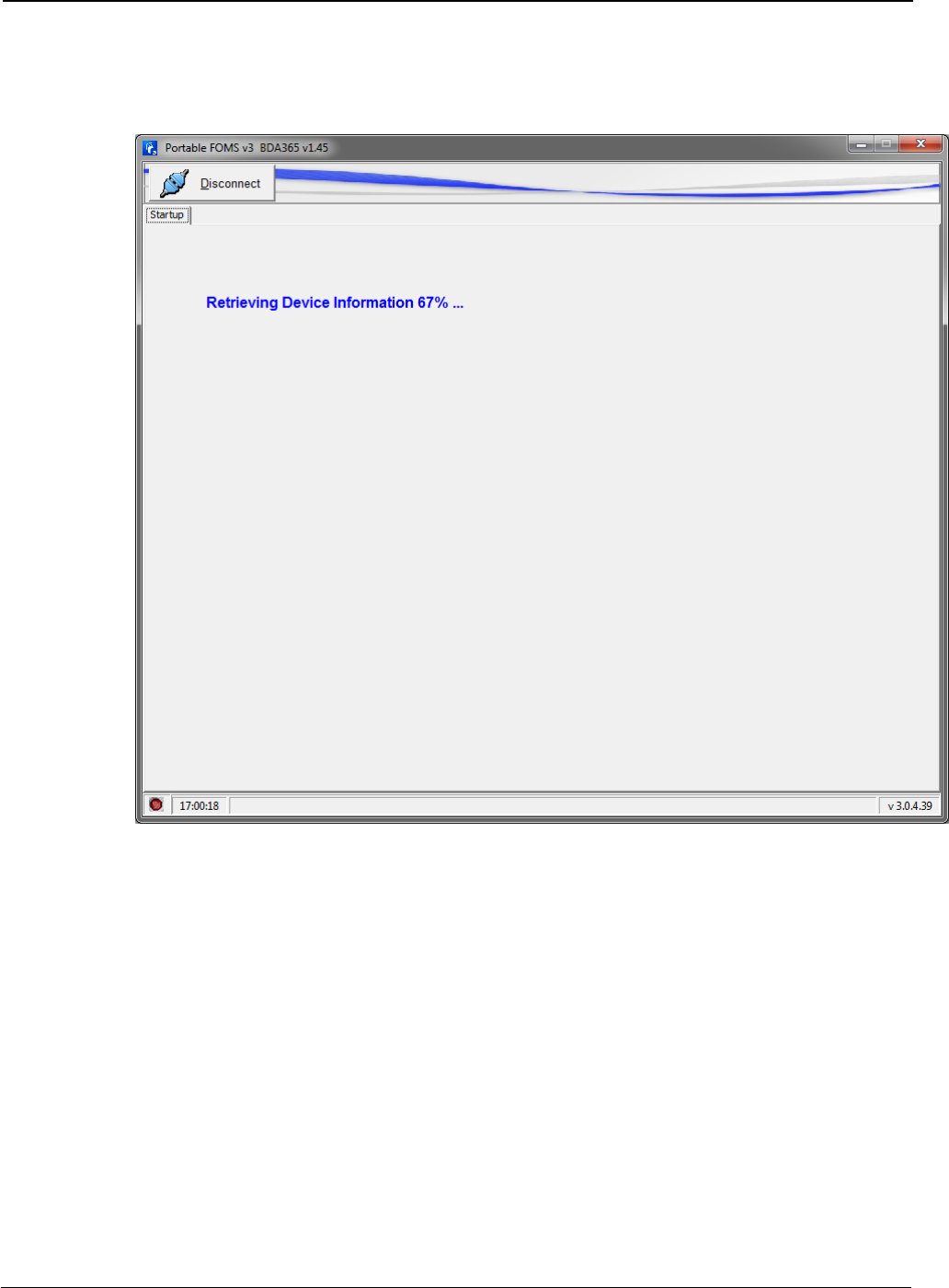
UM-0825 33
After clicking in ok a new window will be active while the Signal Booster is transferring
information with pFOMS.
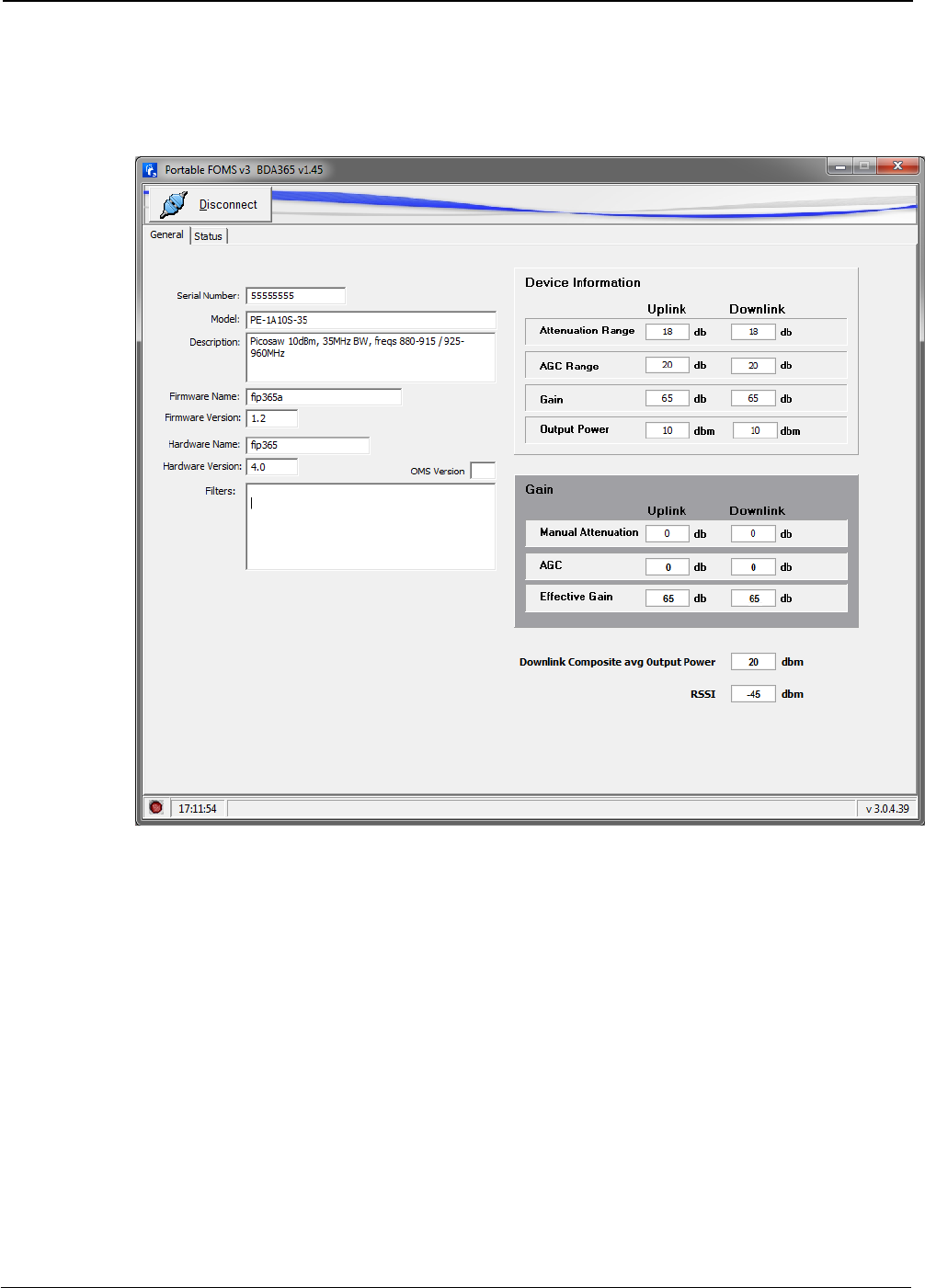
UM-0825 34
8. Overview
General Tabsheet
This tab sheet displays general information from Signal Booster.
First eight fields at the upper left corner of the window displays identity information of the Signal
Booster, this information is stored at Signal Booster’s firmware.
Modem information is displayed at the bottom left corner, these read/write fields allow user to set
up wireless connection via modem when available.
Device Information: four fields at the upper right of the window displays static nominal value of
the Signal Booster, this information is shown by pFOMS after detecting Signal Booster model.
Gain: these fields allow user to know actual manual attenuation, AGC, and effective gain of
Signal Booster, this is dynamic information, constantly and automatically being updated by
pFOMS.
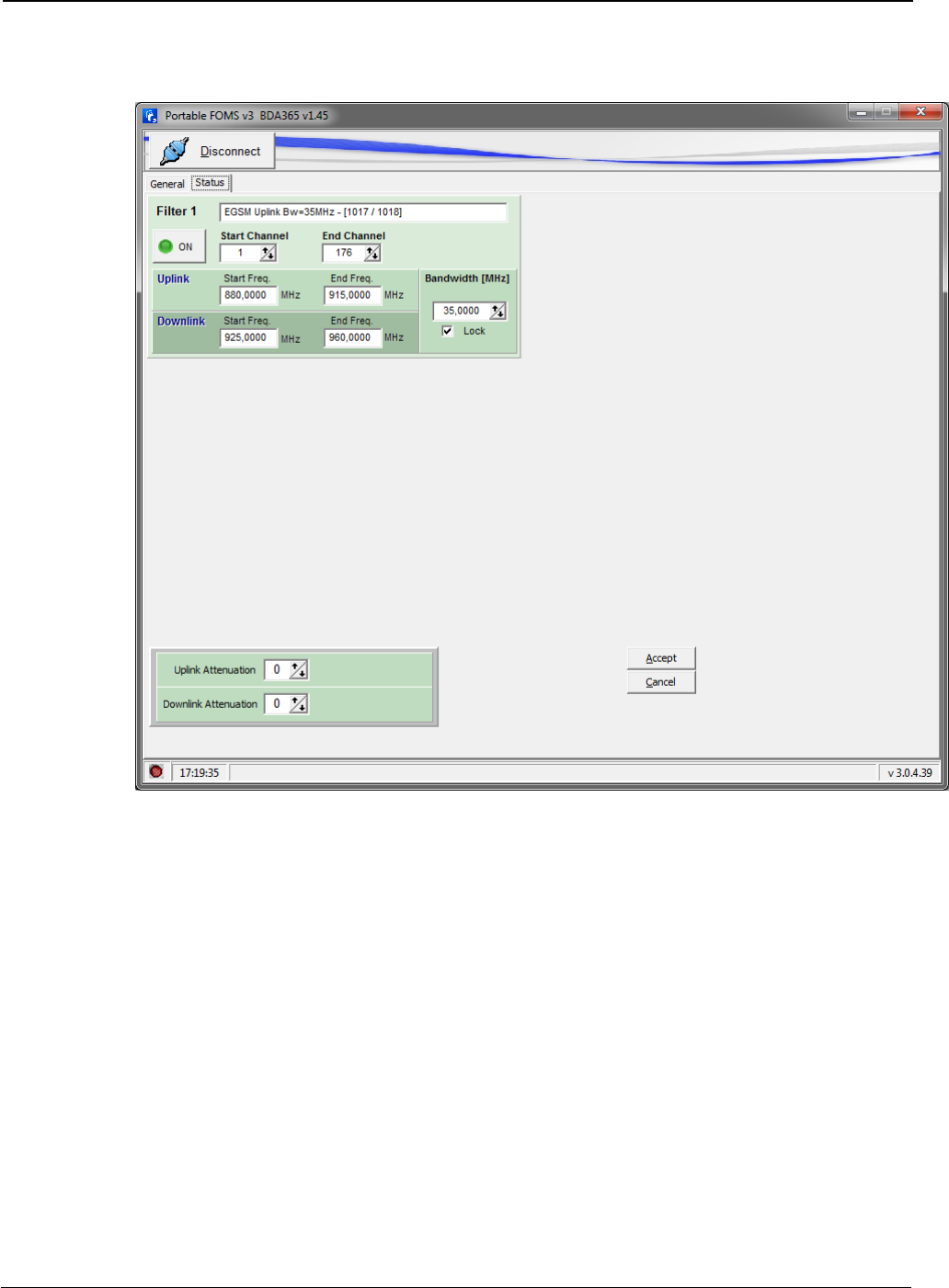
UM-0825 35
Status tab sheet
This tab sheet shows configurable parameters of the Signal Booster:
Filters can be programmed over its working range. Some can be moved, some can be turned on
and off, other have fixed features and are not meant to be modified.
They can be moved or turned on/off enabled filters will appear in green, disabled (powered off)
filters will be sown in red. Band selective programmable filters show Start / Stop channel and Start
/ Stop frequency.
Channel selective programmable filters will only show Start channel, in this case the meaning for
start channel is filter center BW channel.
Band selective fixed filters will show start frequency or channel and the meaning is center BW
frequency or channel.
Manual attenuation: shows the status of uplink and downlink attenuation.
PA: shows power amplifiers operative status. Some Signal Booster may not have this feature.
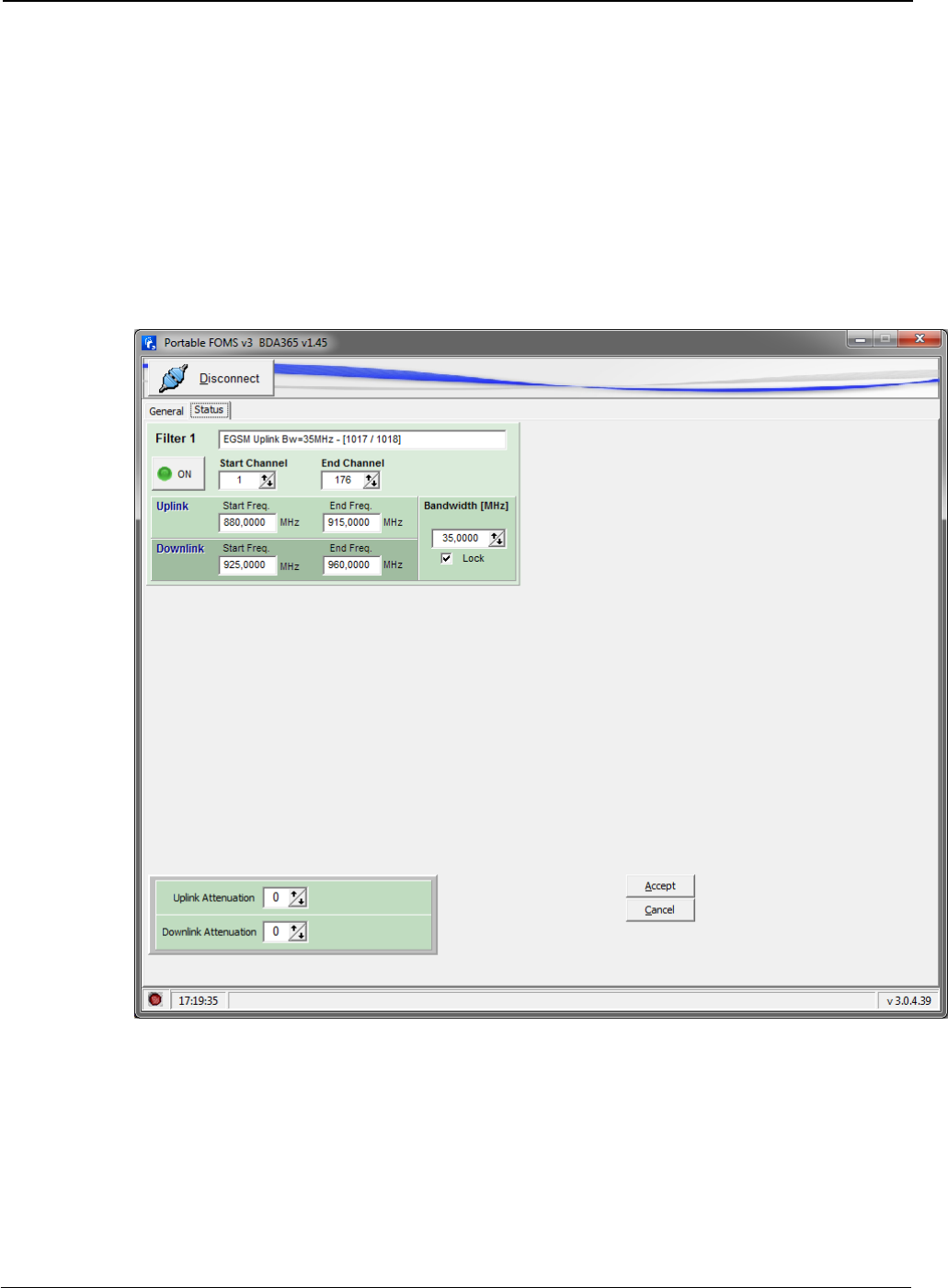
UM-0825 36
Configuration
Filters and attenuation controls can be edited by clicking in the up/down arrows. After having set
the new desired parameters, user must click in Accept button in order to send the new parameters
to the Signal Booster.
For operations in the Upper 700 MHz PS-BB spectrum (758-768 MHz and the 788-798 MHz
bands) the TX filter shall be set to:
· Downlink Start Frequency shall be greater than 763 MHz
· Downlink End Frequency shall be less than 768 MHz
· Uplink Start Frequency shall be greater than 793 MHz
· Uplink End Frequency shall be less than 798 MHz
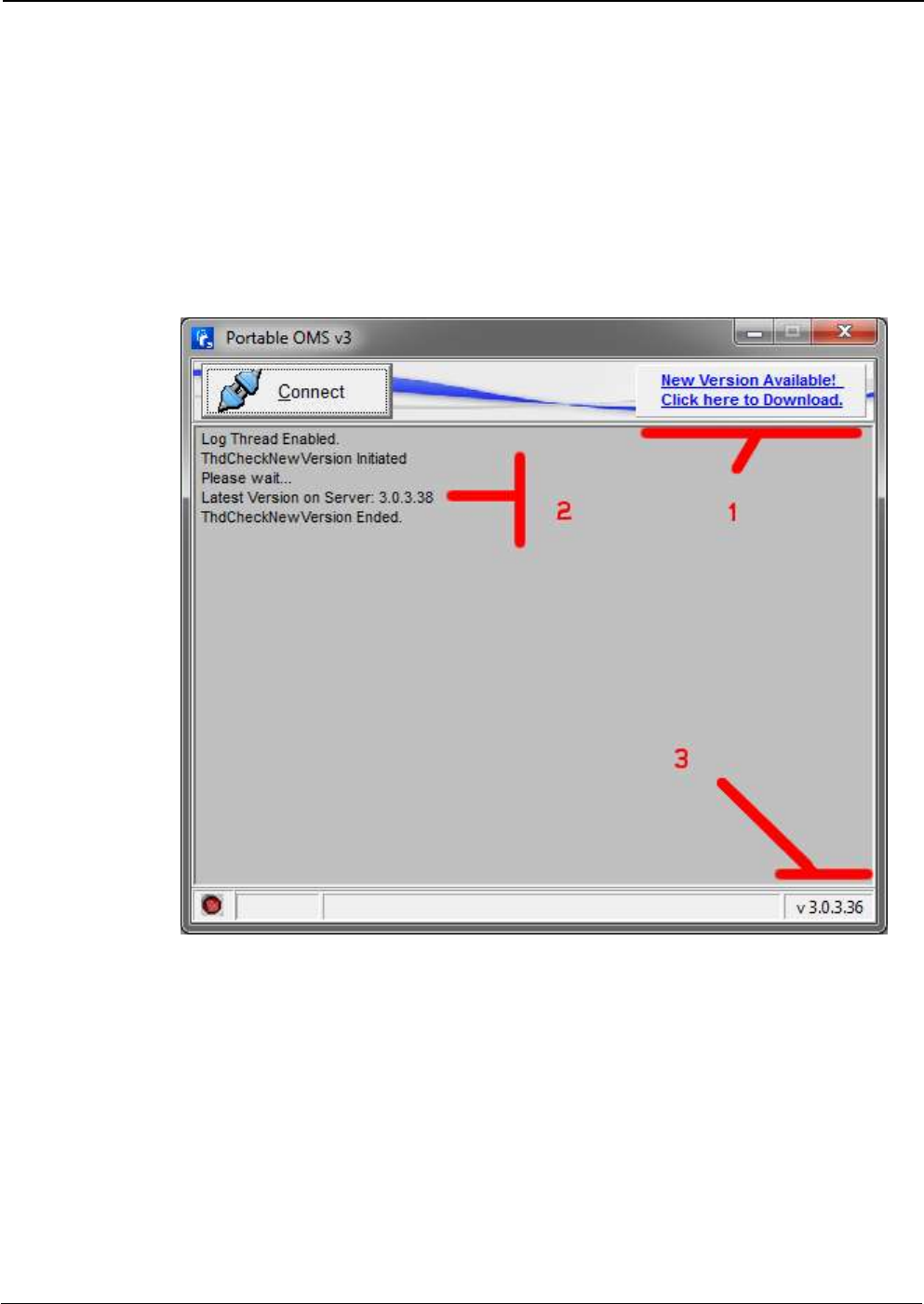
UM-0825 37
Update Features
The Fiplex Portable OMS v3 software has a new feature that will check if there’s a new OMS
software version present.
If a new version is available a direct download button will be shown (1).
In (2) you can check the latest server version available. It is recommended but not mandatory to
have the latest version installed as it will have support for more devices.
In 3, you can watch the current software version.
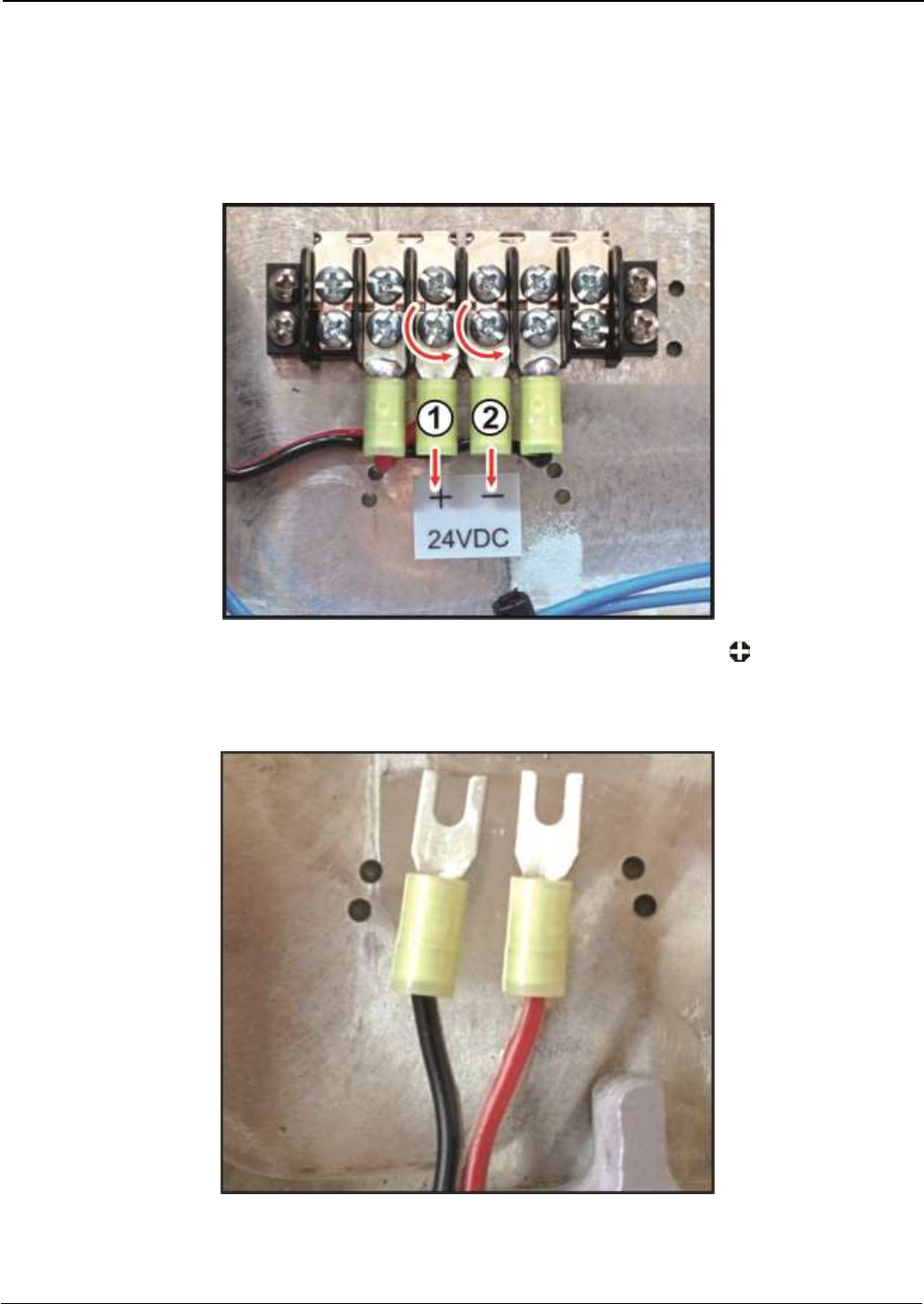
UM-0825 38
ANNEX 1 - 24 Volts DC Operation
This Signal Booster can have the option of being powered externally with 24 volts DC voltage. To
connect the DC Power to Signal Booster follow the next steps.
Remove the fork terminals 1 & 2. Use a phillips screwdriver No.1
Crimp the Fork terminal to the wire
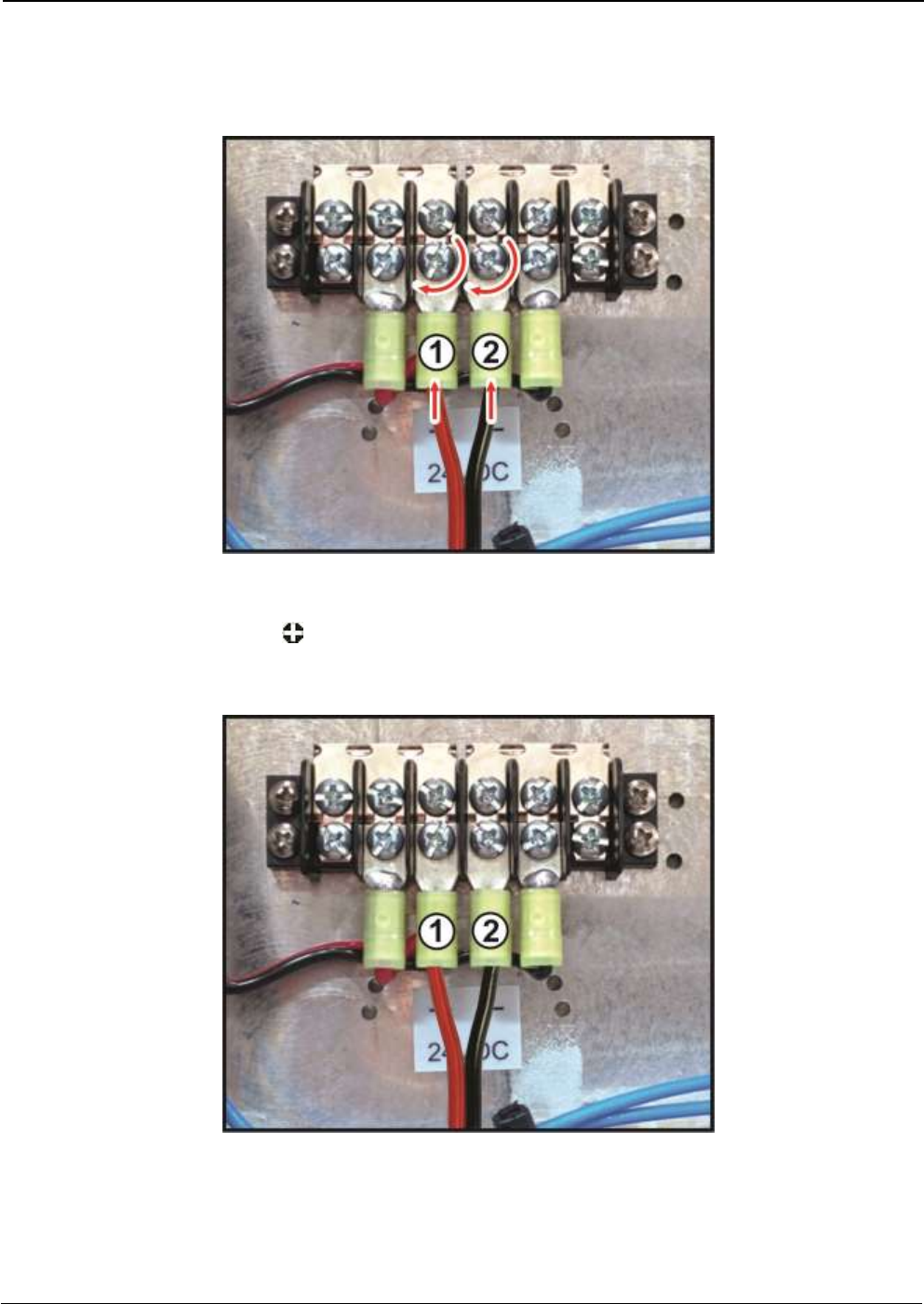
UM-0825 39
Before starting the crimping process, please confirm that the wire to be used is within the range
of the chosen crimping terminal.
Connect the terminals to the terminal barrier and tighten the screws clockwise. Use a phillips
screwdriver No.1
Verify that there is no short circuit between terminals 24VDC(1 & 2)
Connect 50Ohms loads on the RF Ports and connect the voltage 24VDC. Verify with a multimeter,
the voltage level.
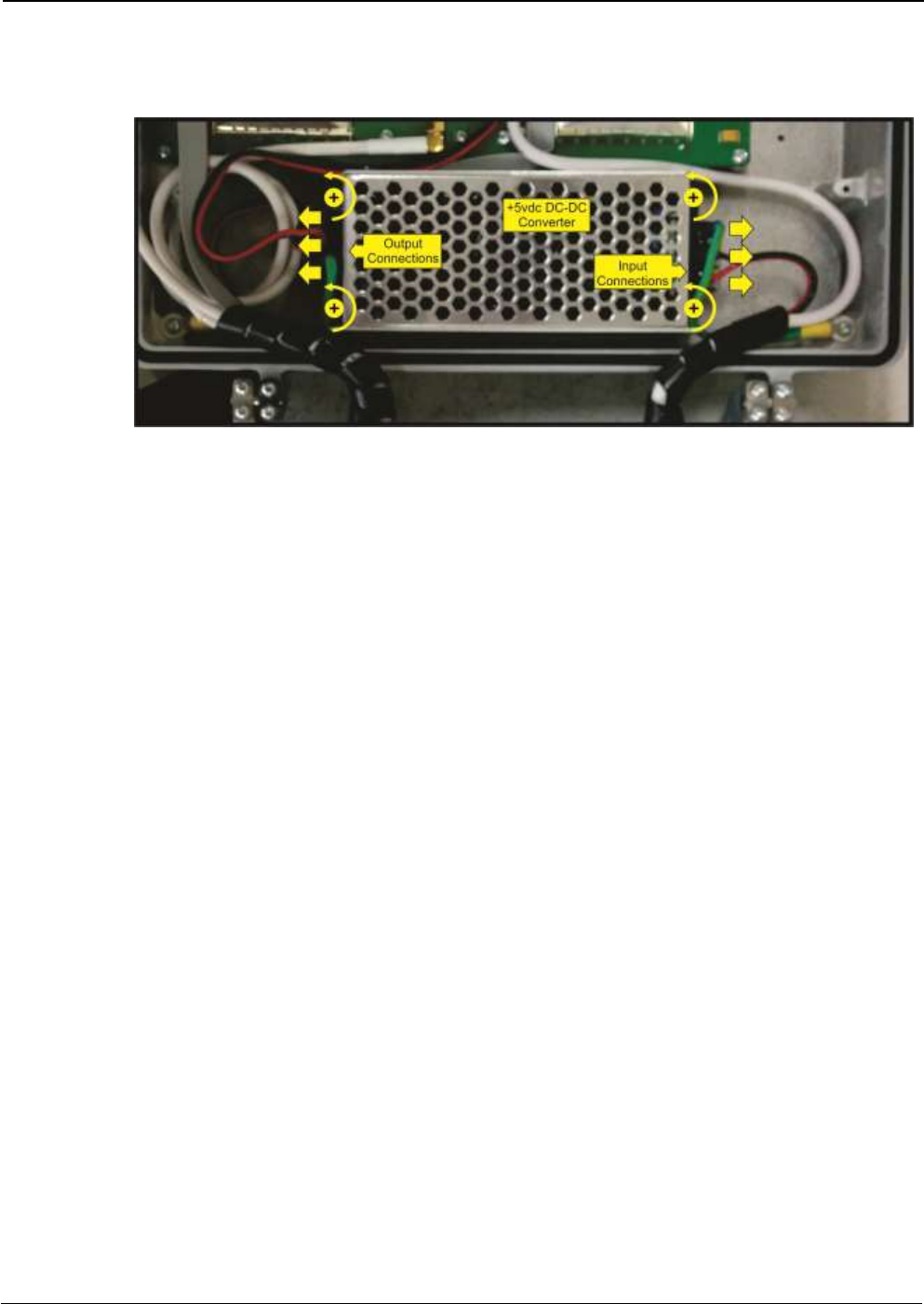
UM-0825 40
ANNEX 2 – Replacing +5VDC DC-DC Converter
Removing the damaged DC- DC converter
Warning Do not touch any of the exposed leads, terminals, or components. Hazardous voltages
may be present in this product.
1) - Disconnect the Main Power.
2) - Remove the Input and Output connections of the power supply.
3) - Release the #6-32 Philips screws(x4)
4) - Remove the power supply.
5) - Install the new power supply